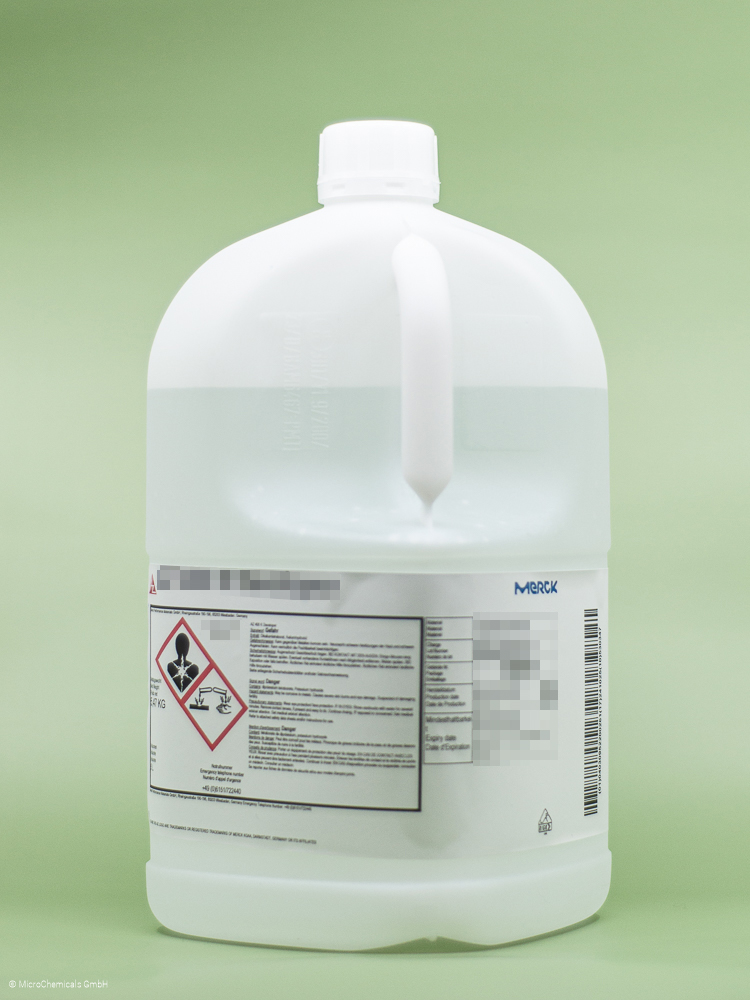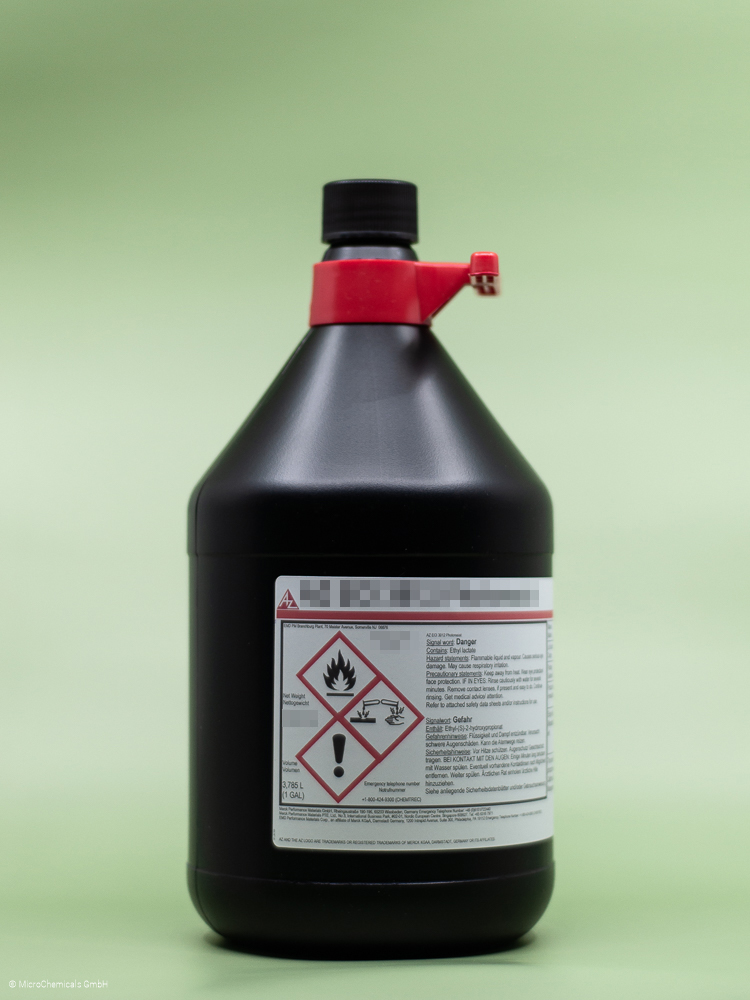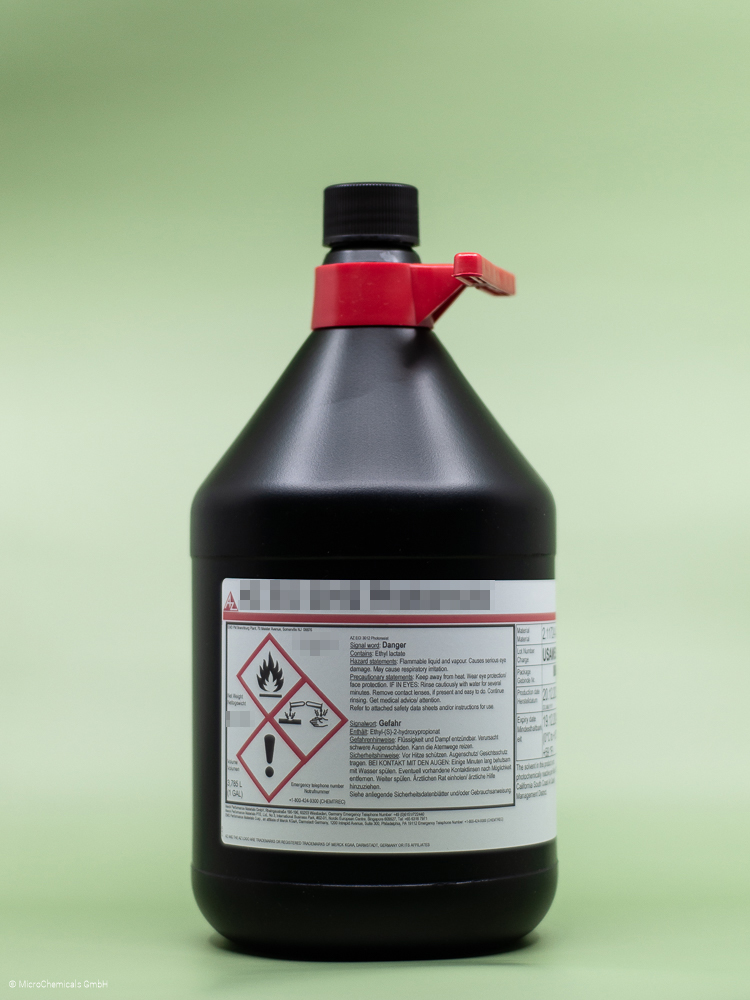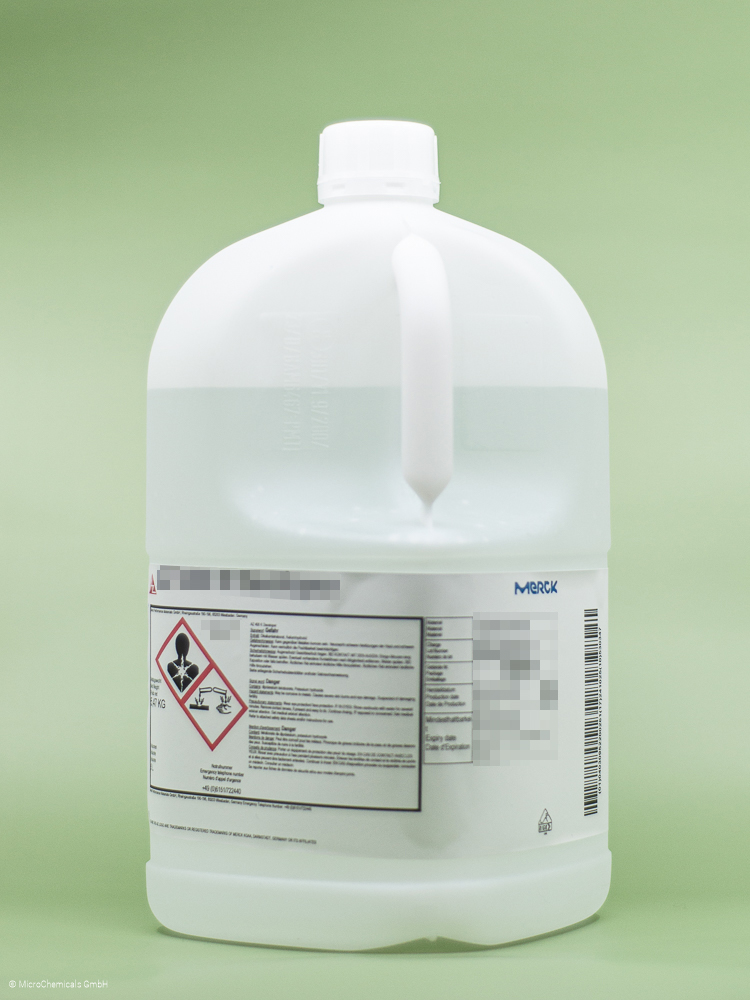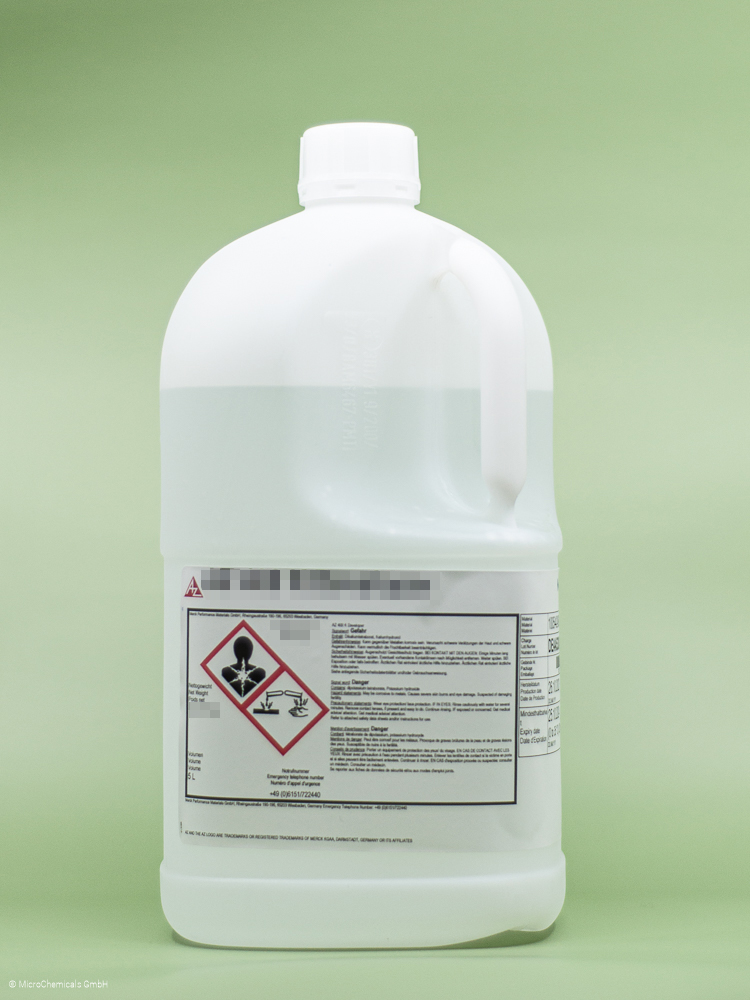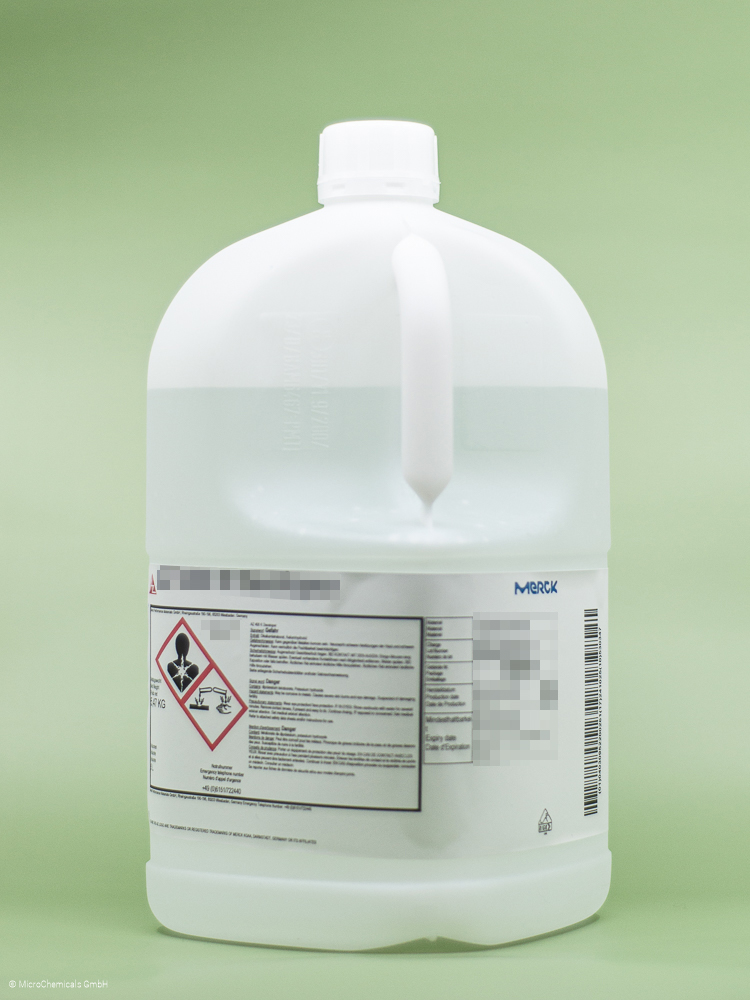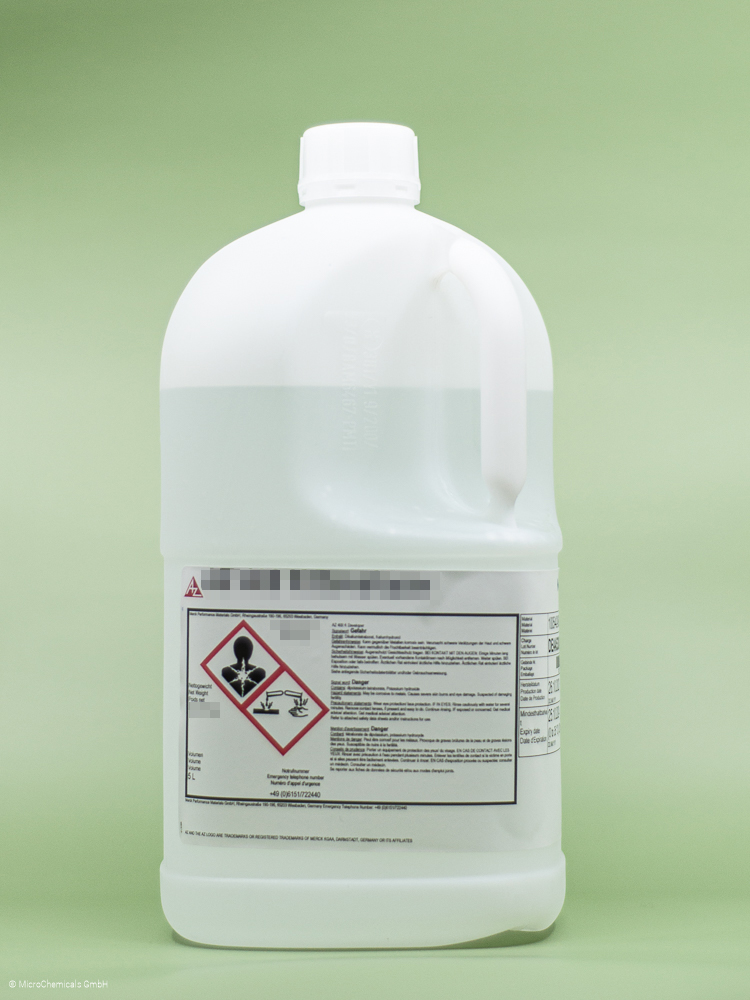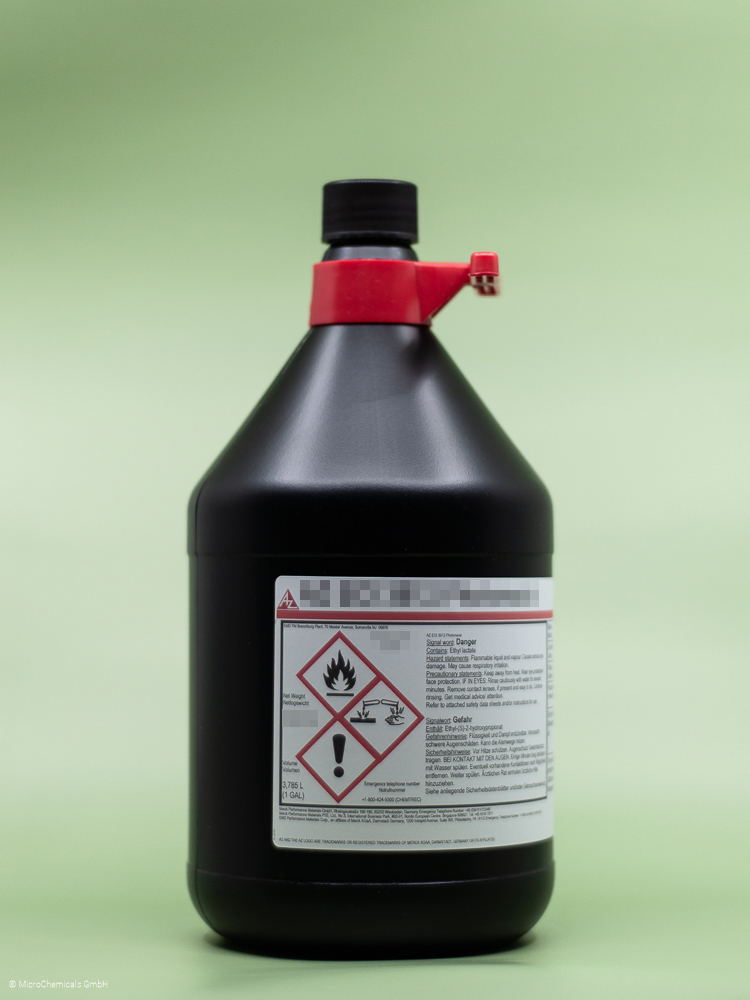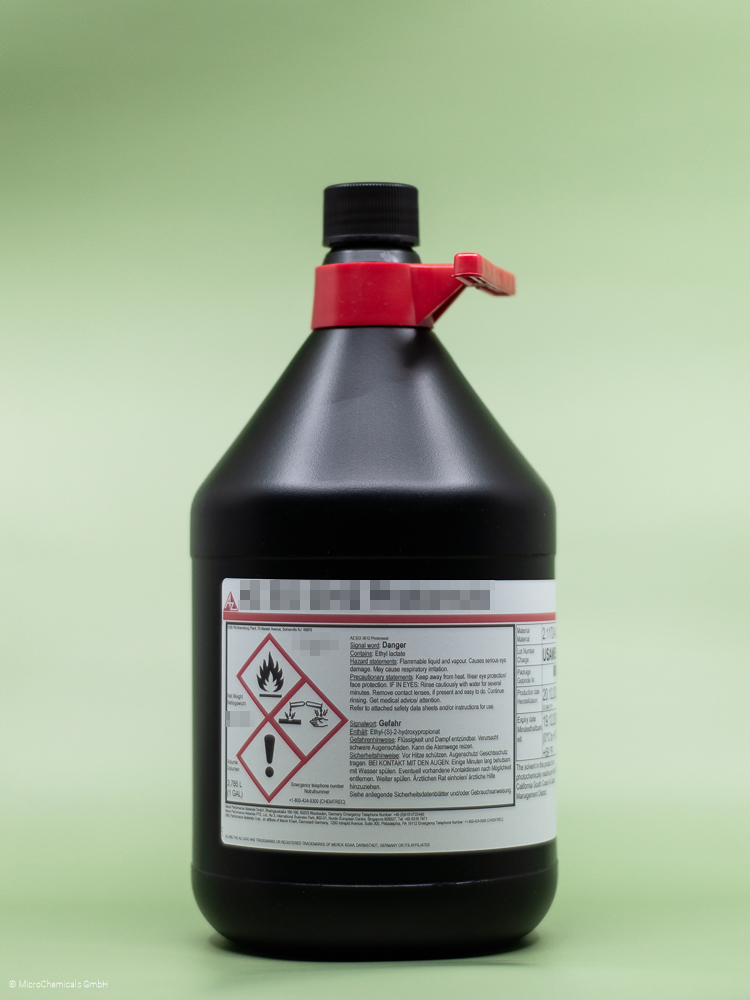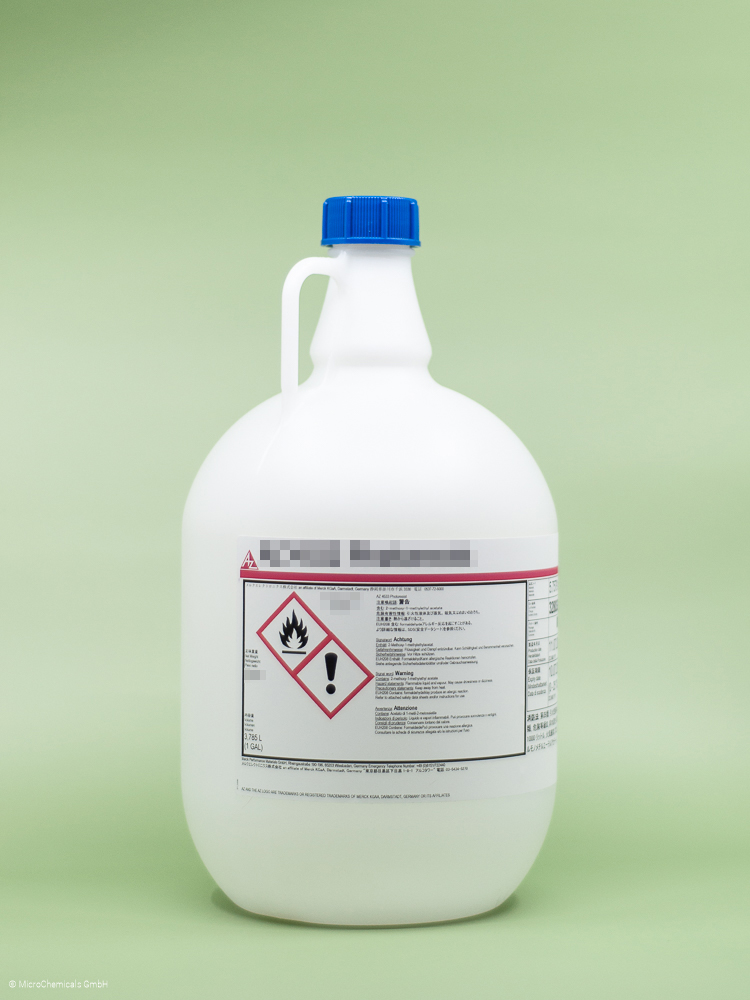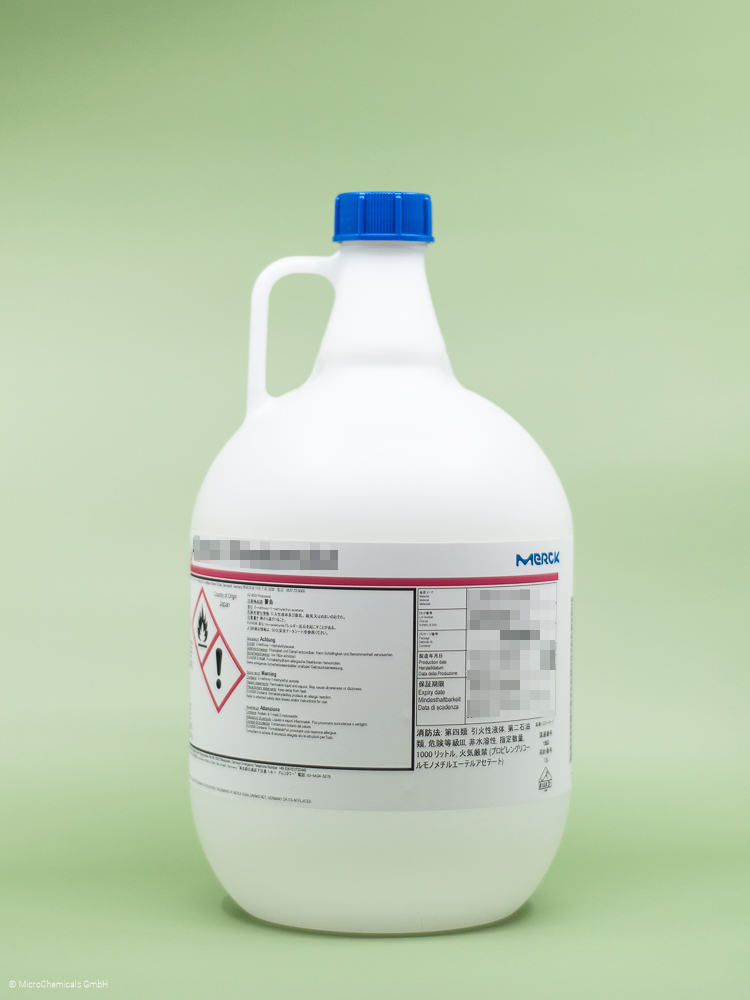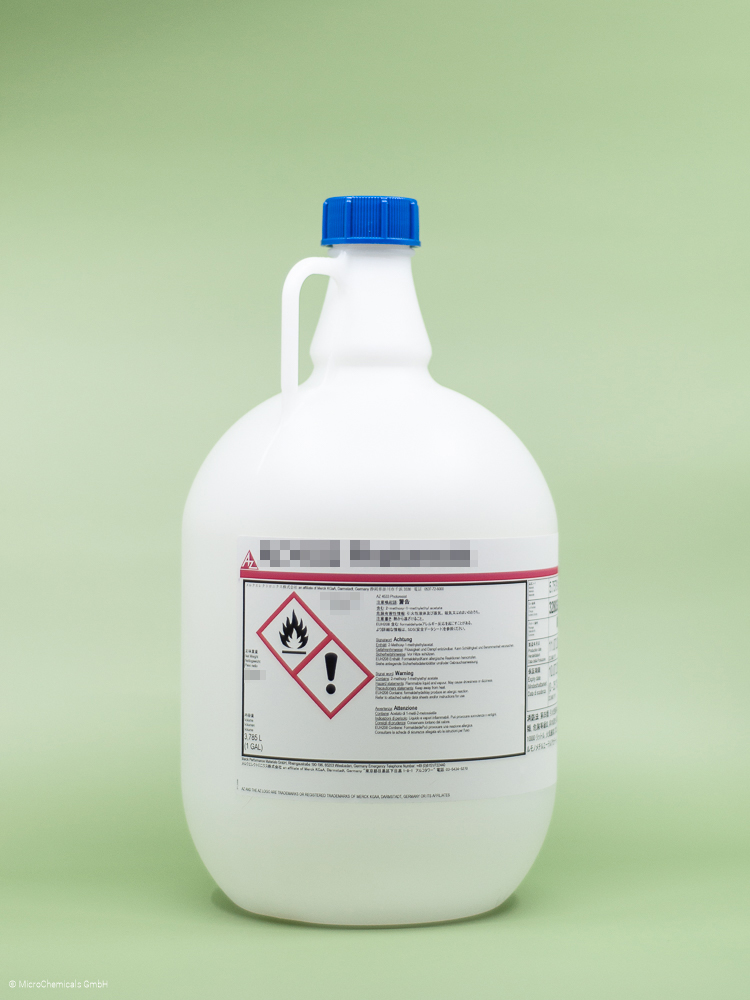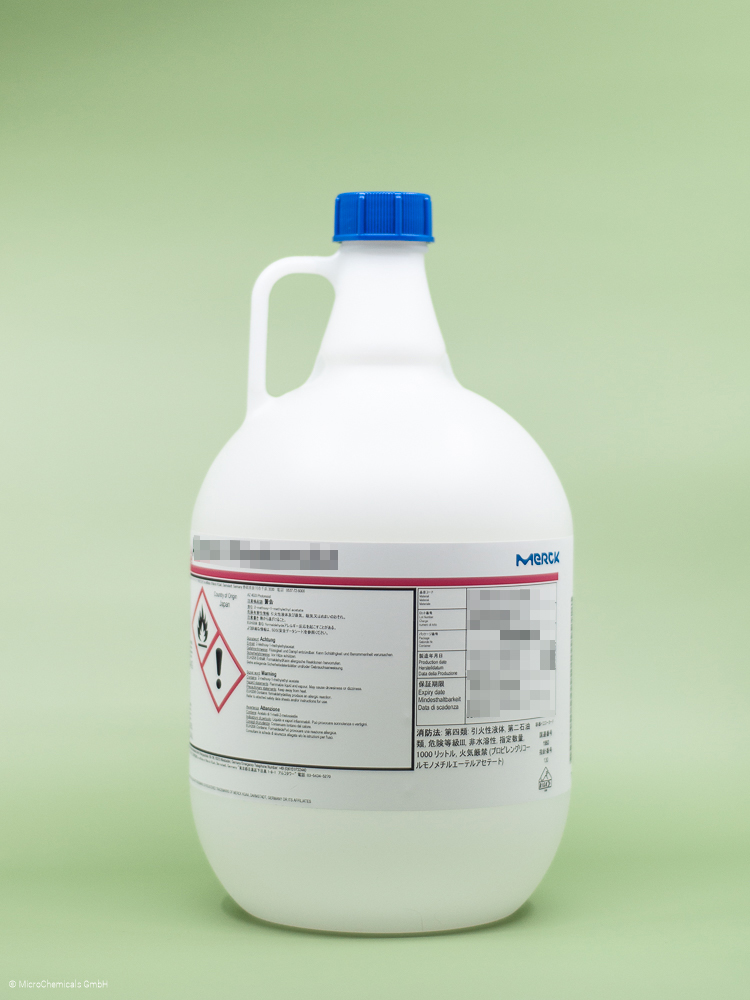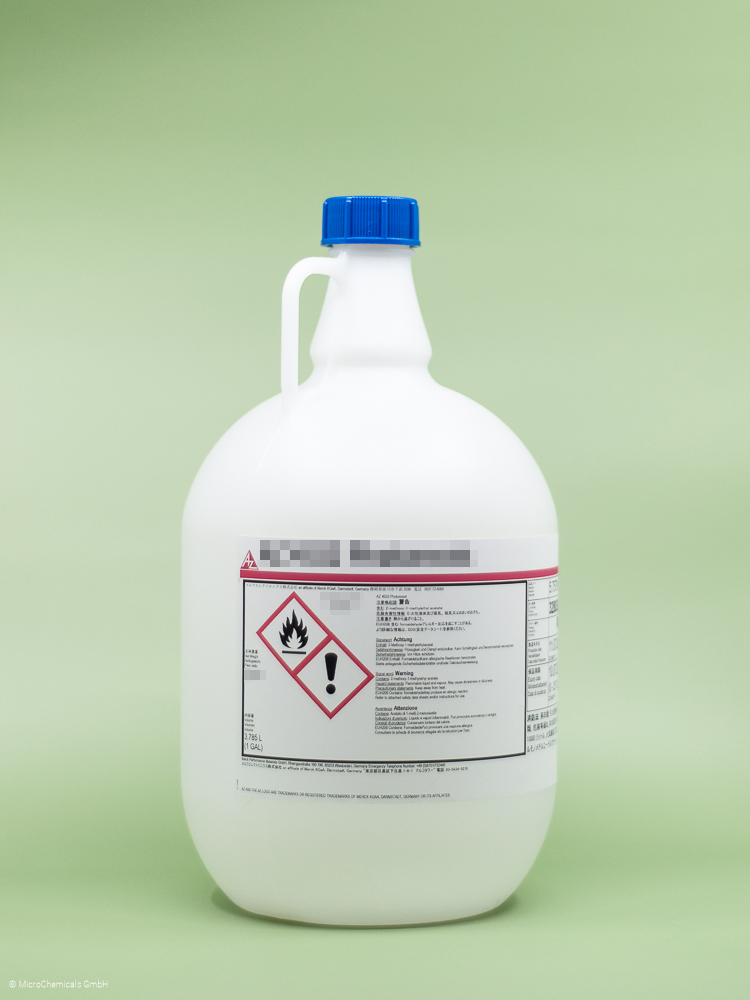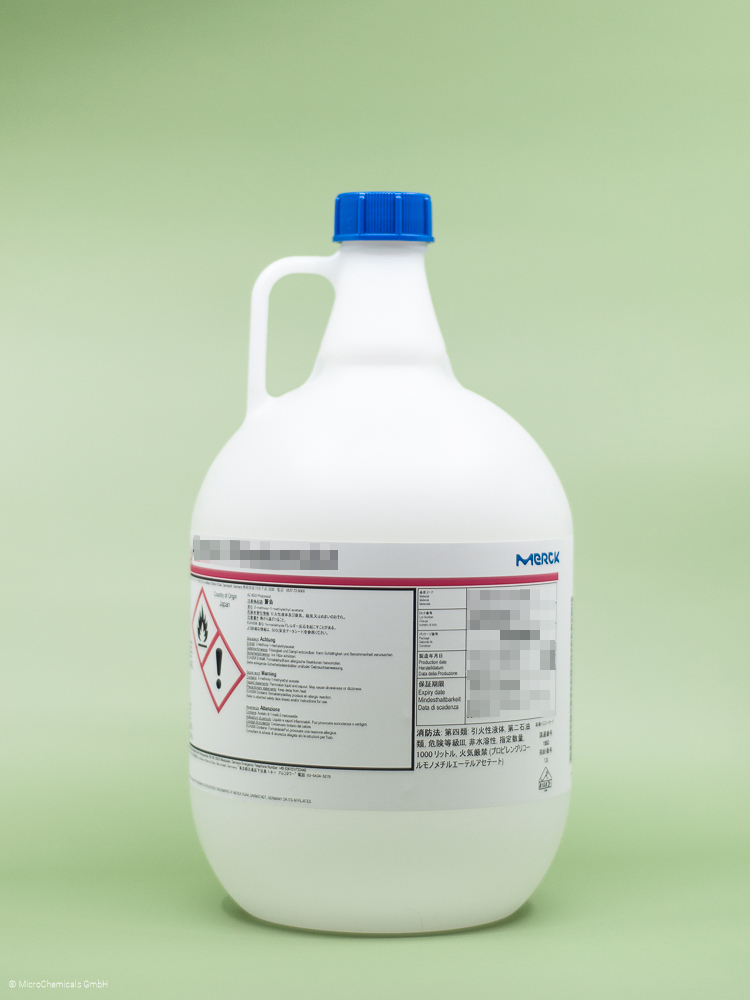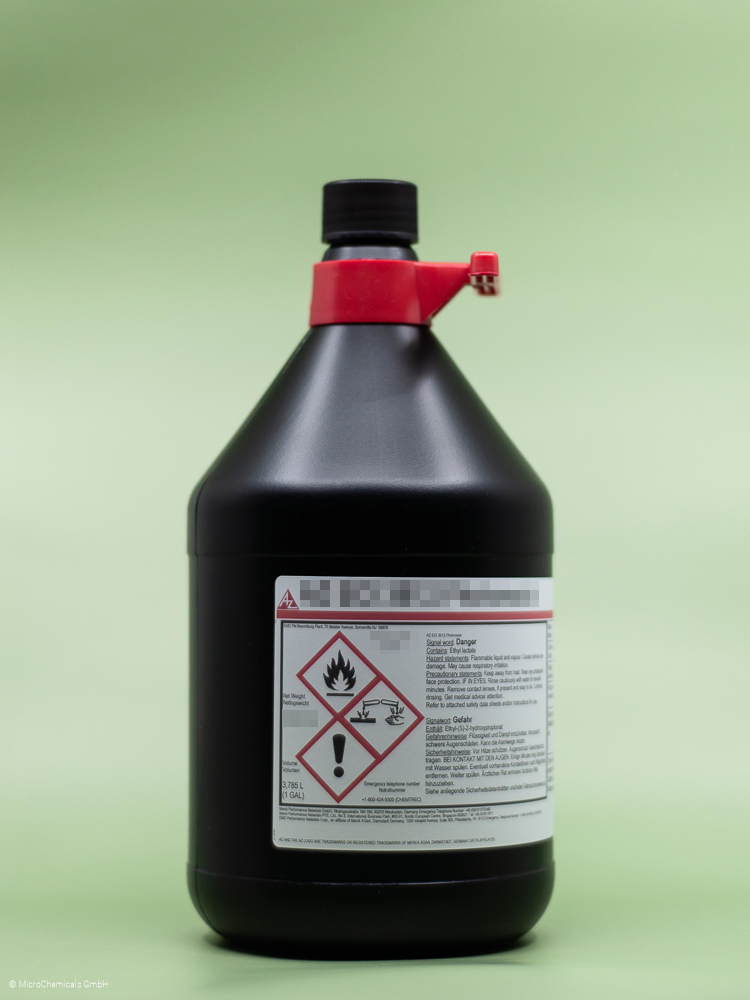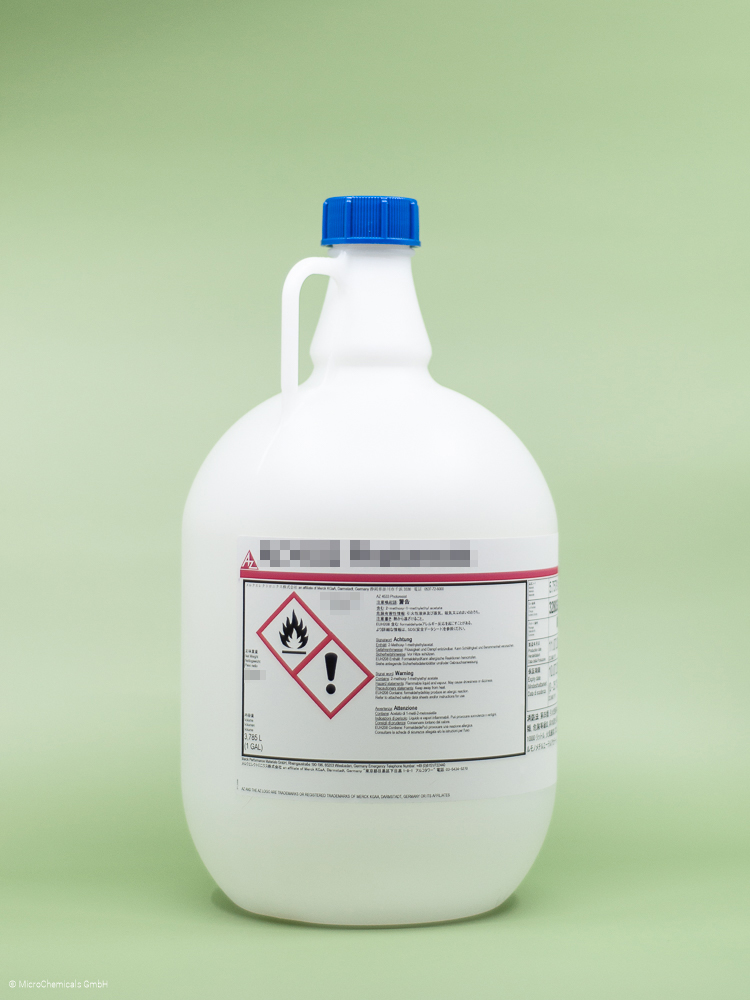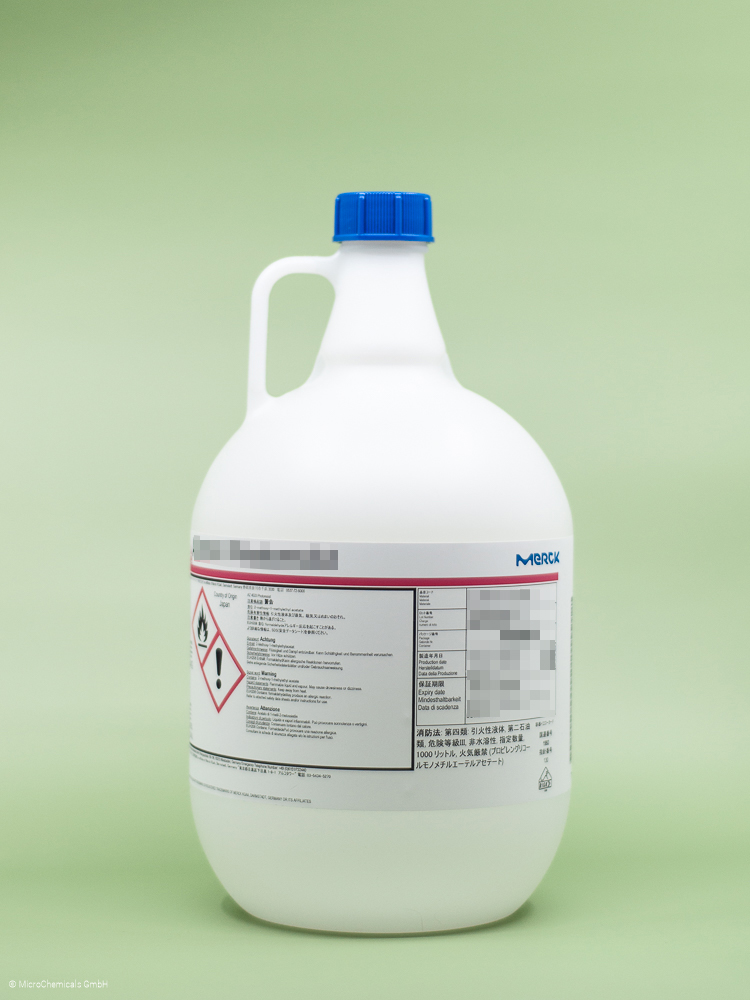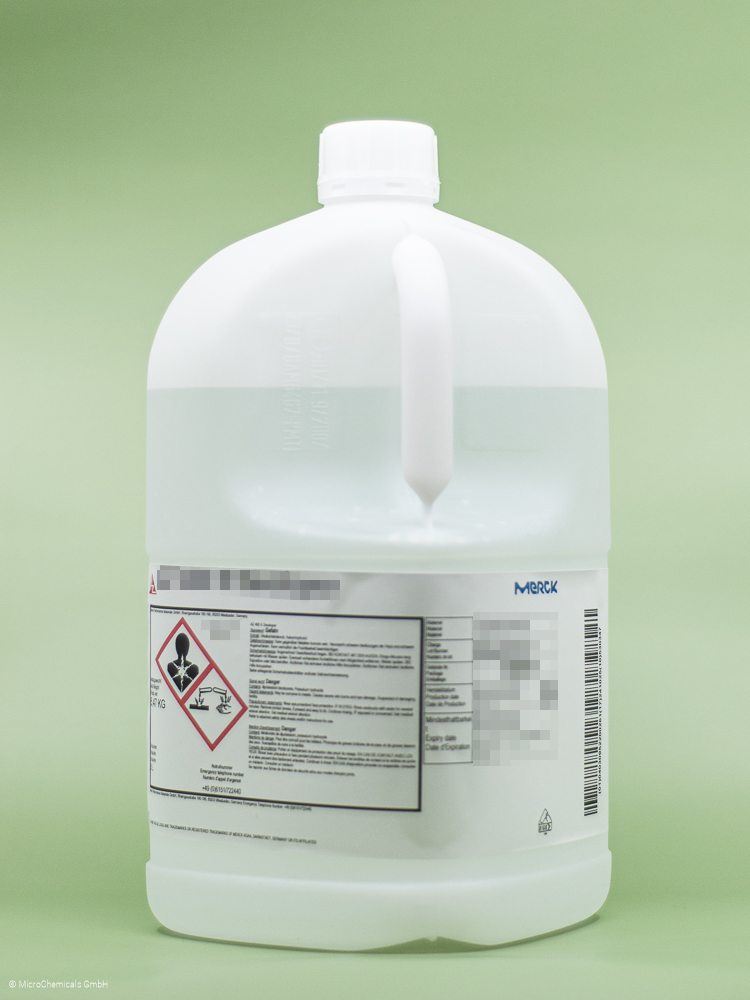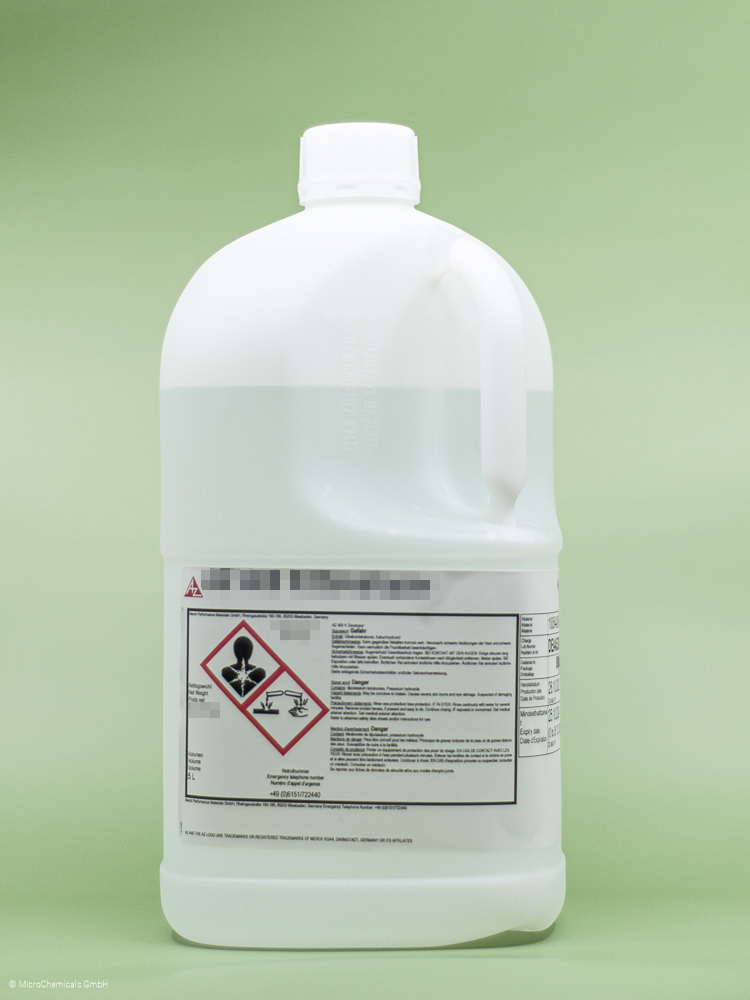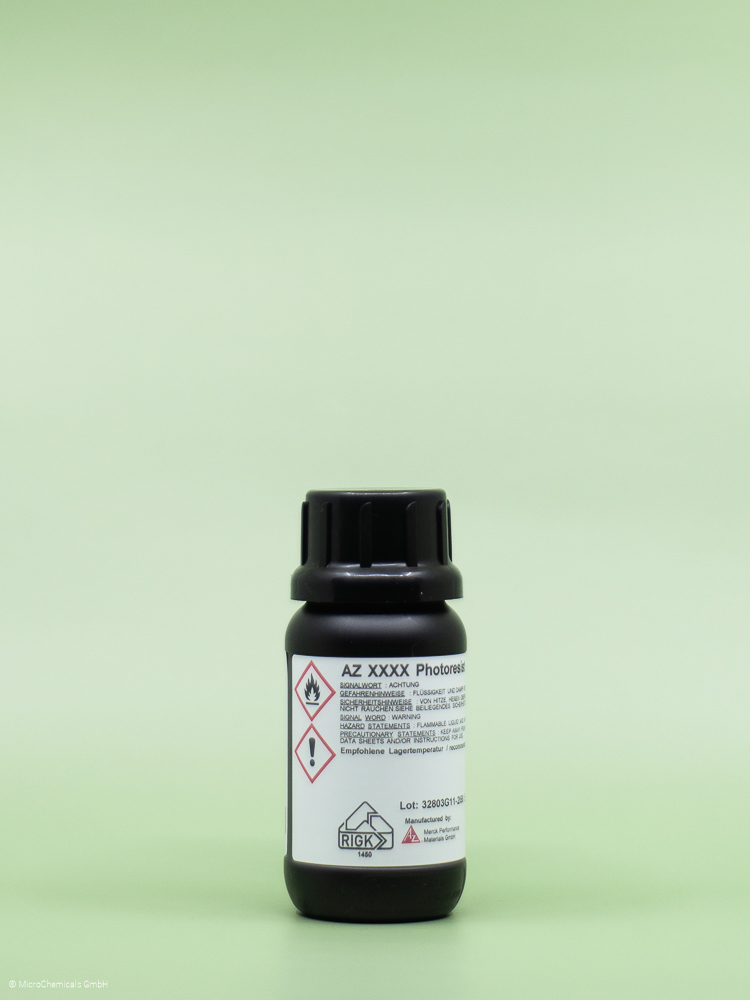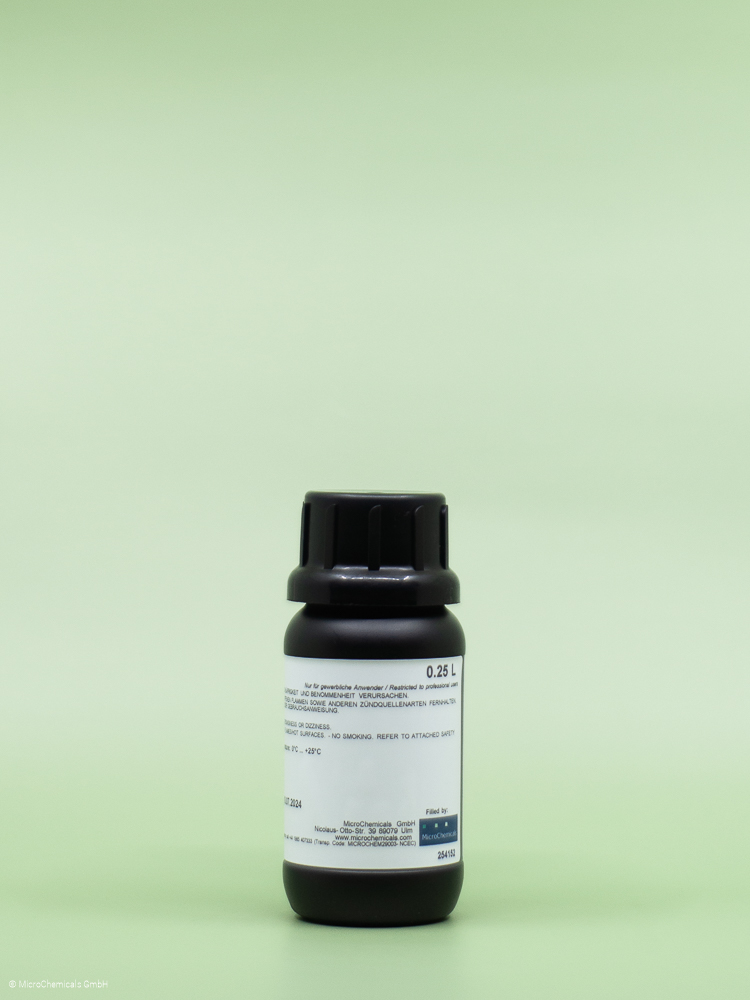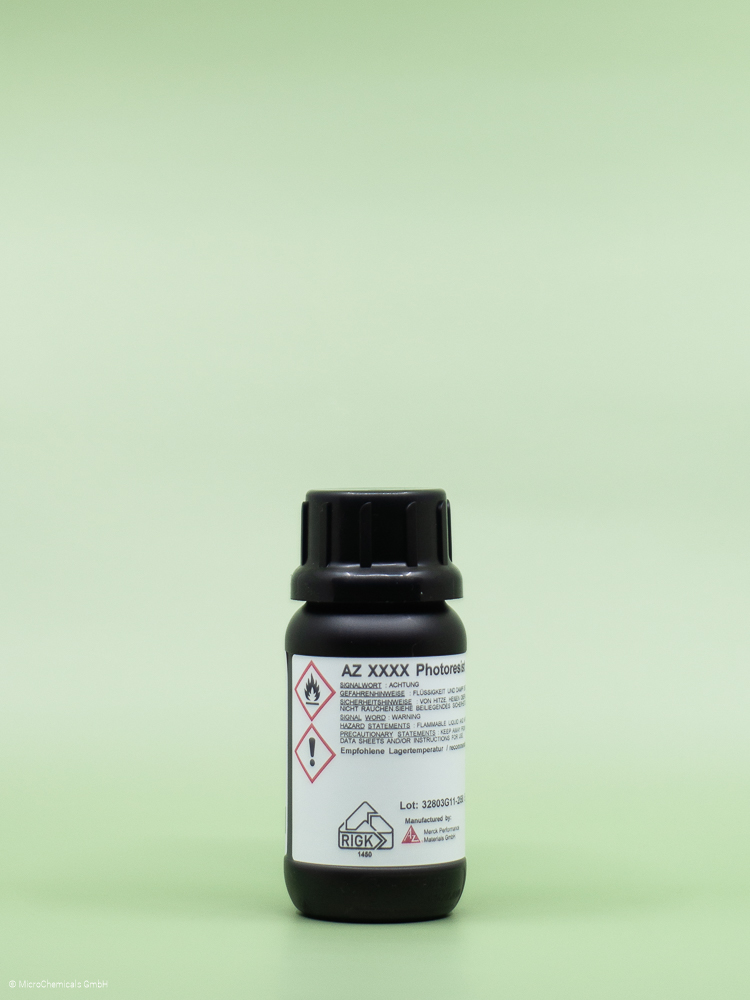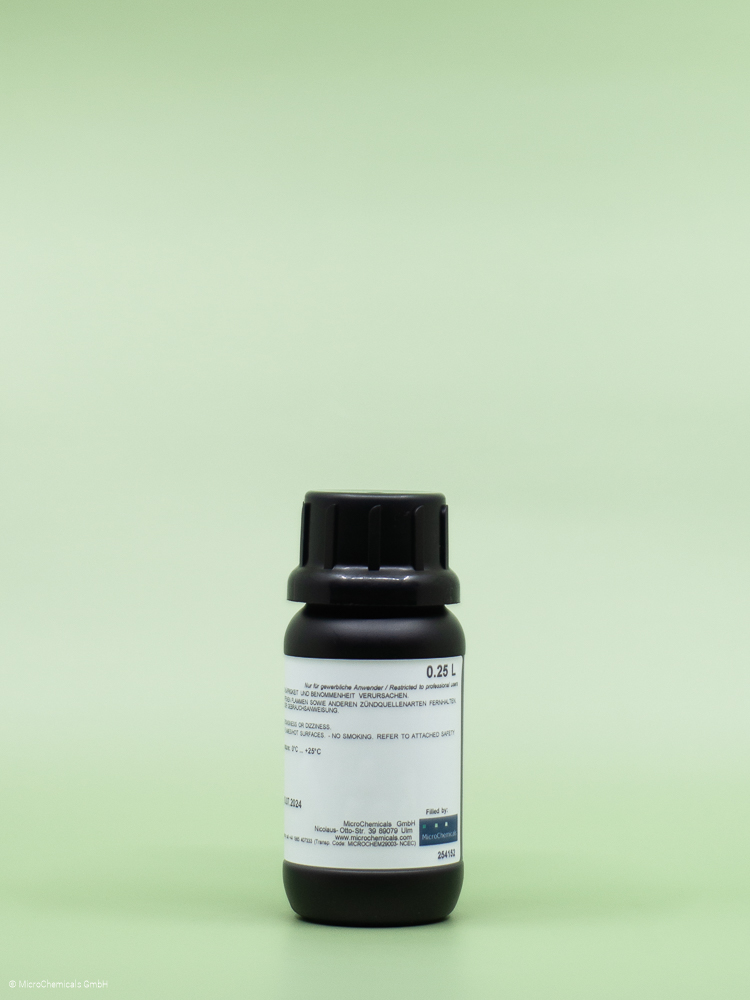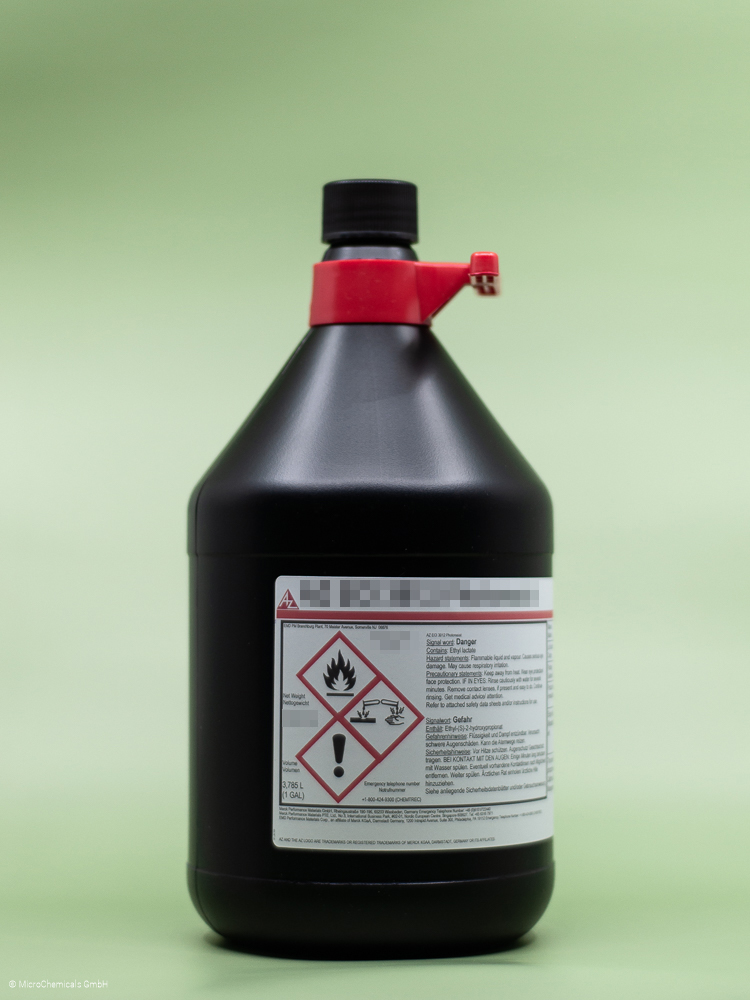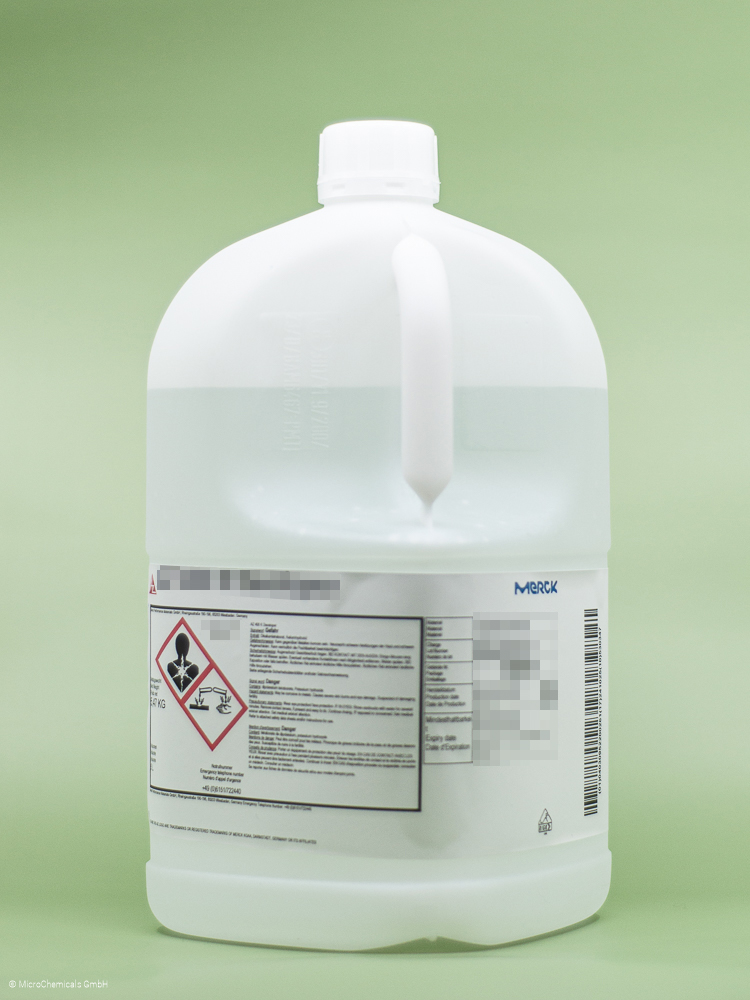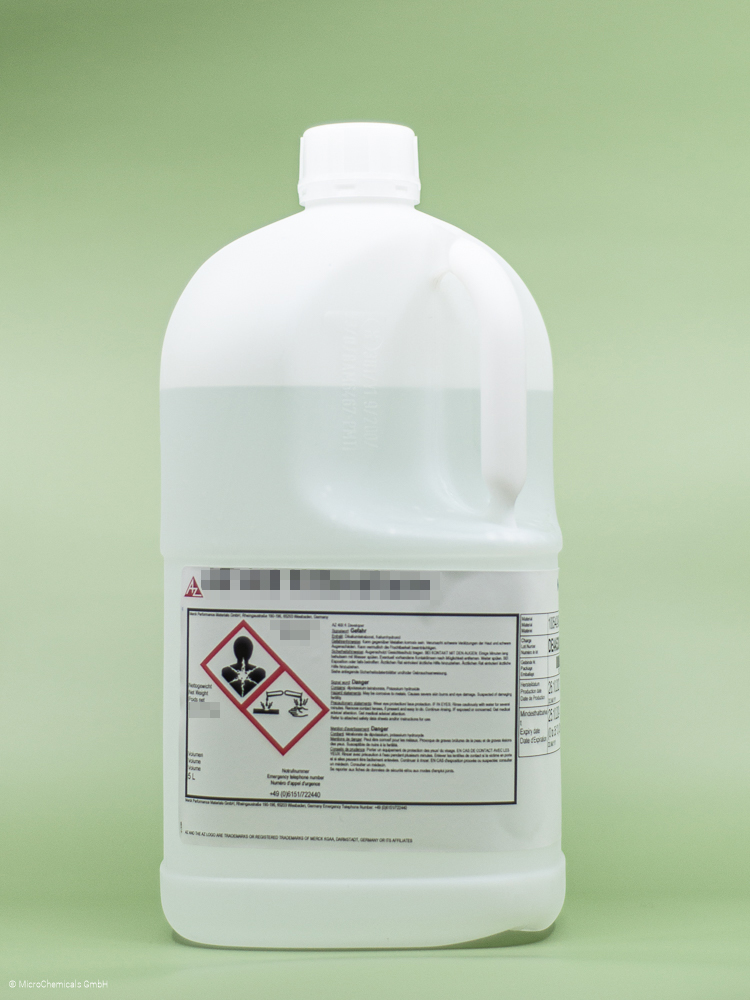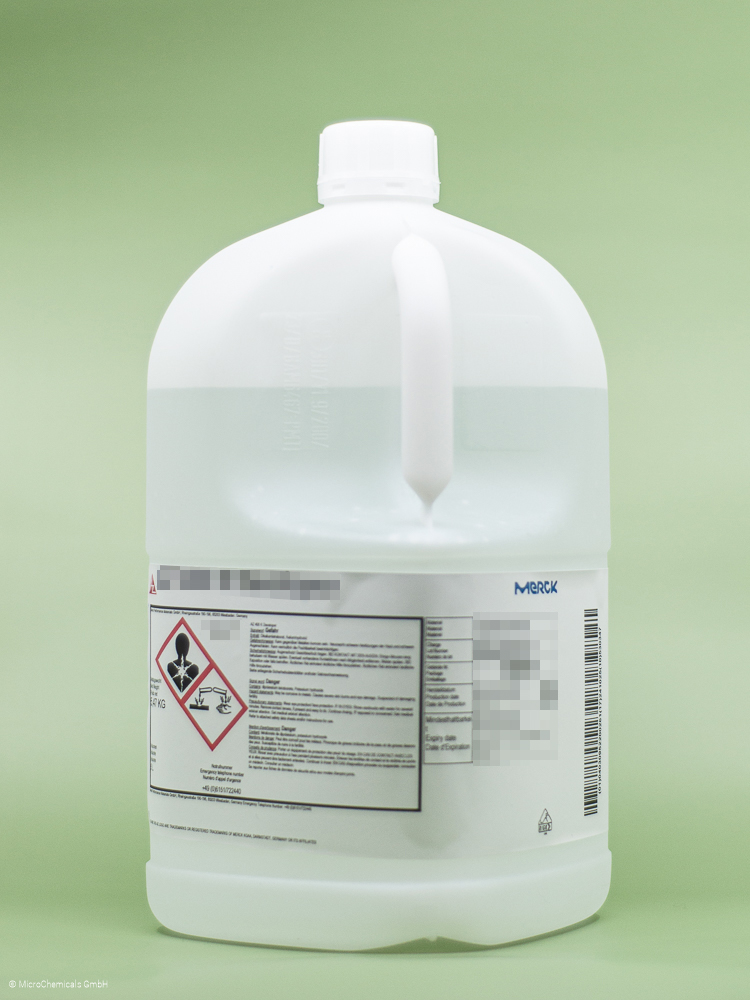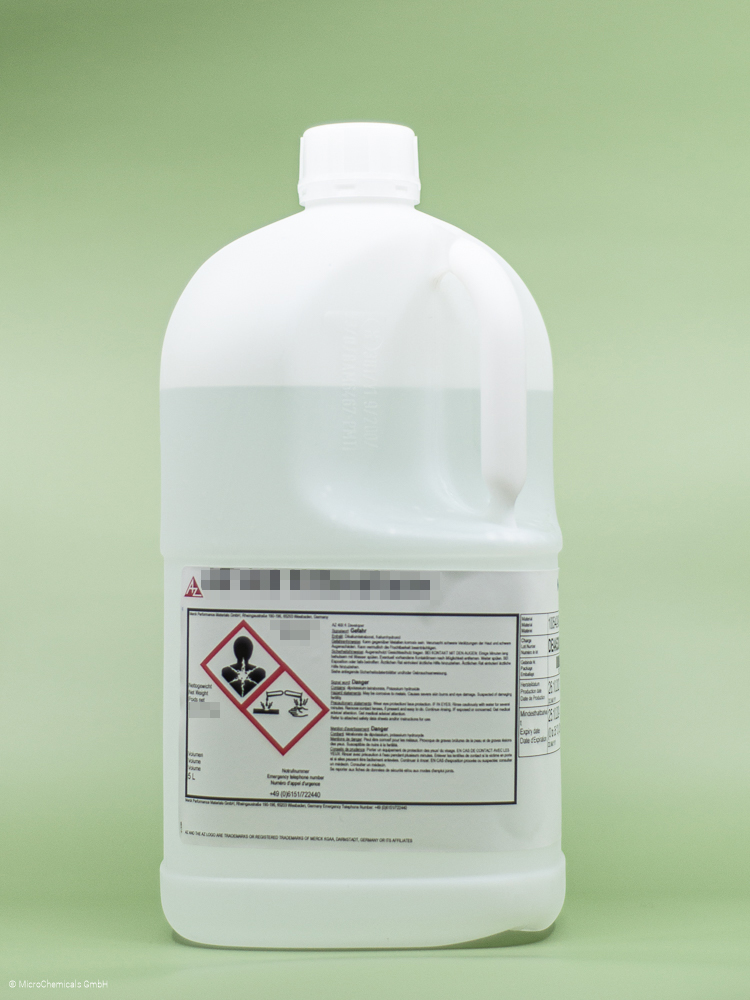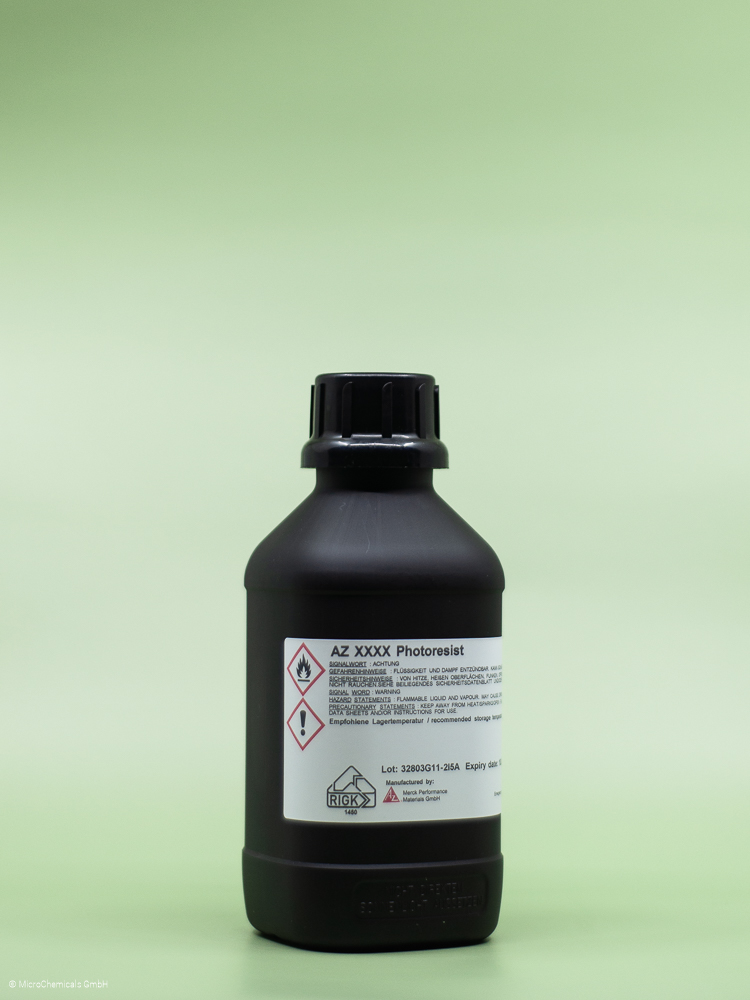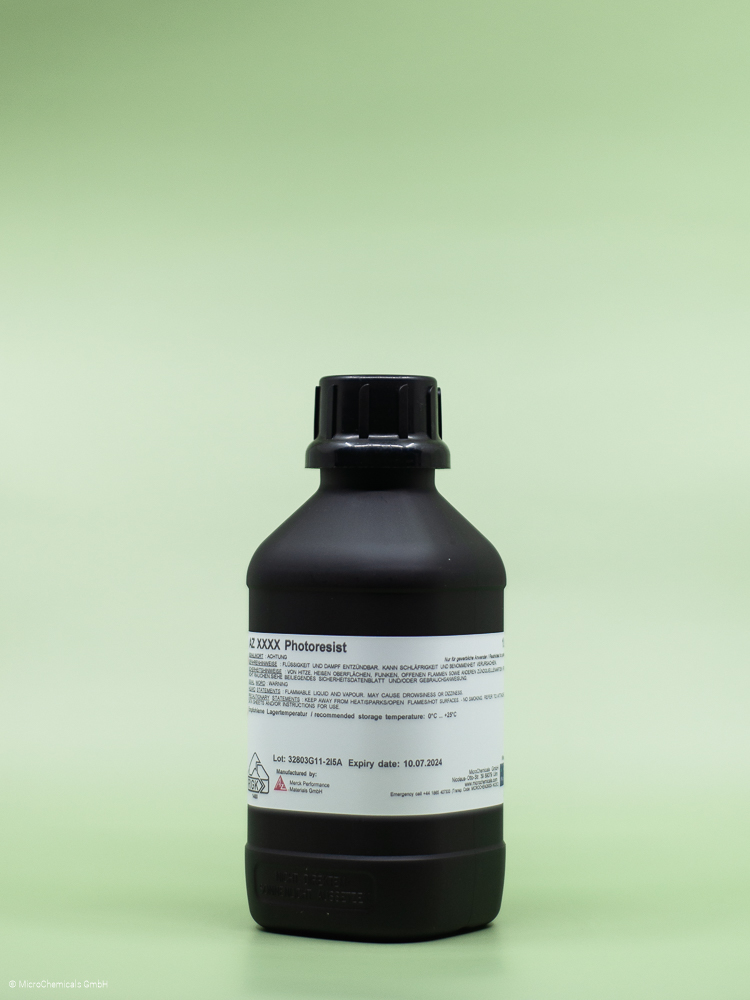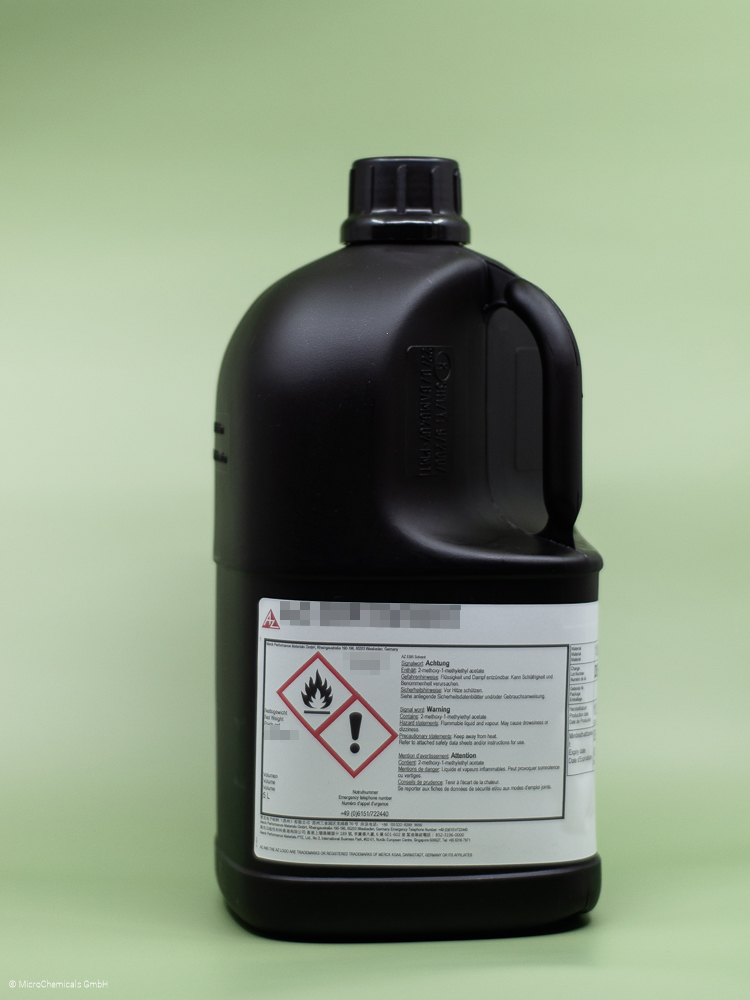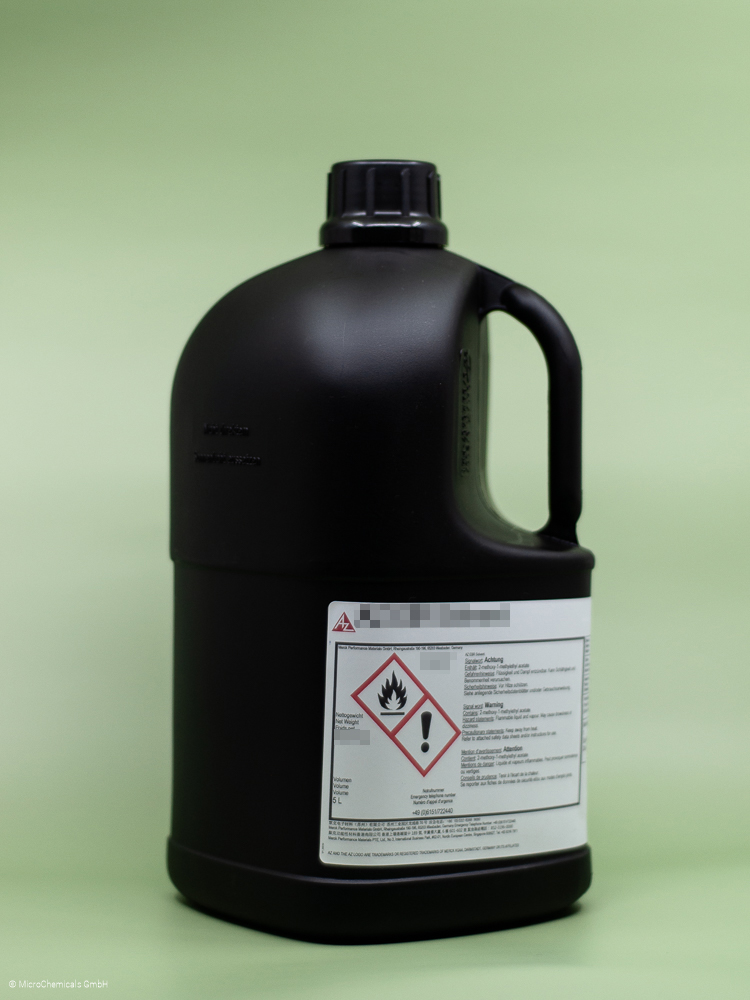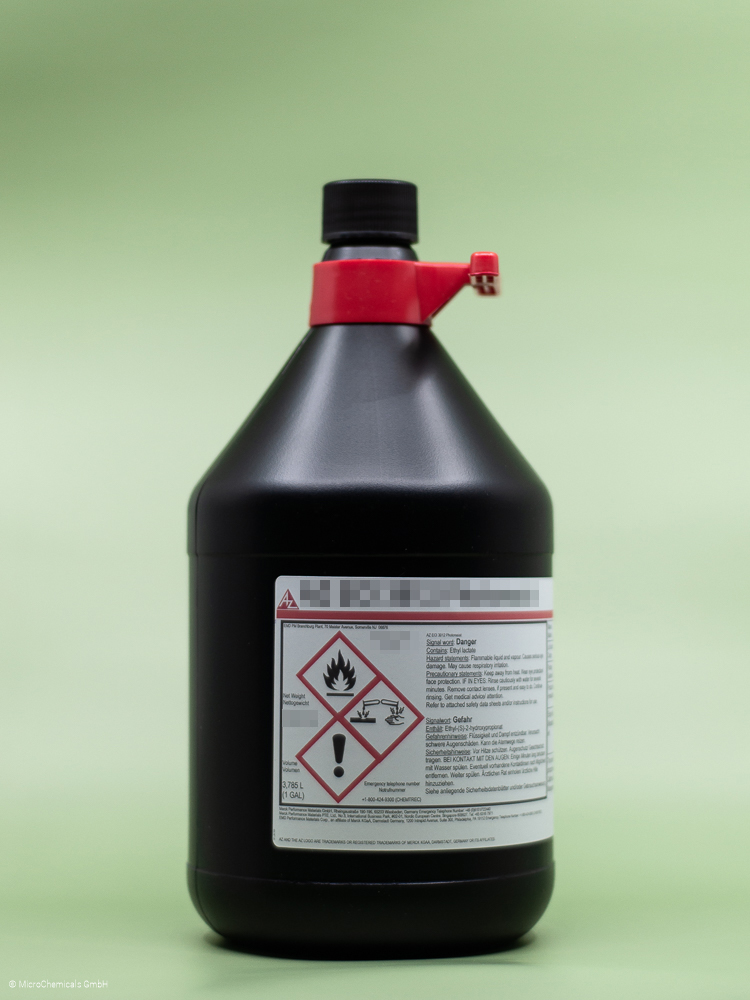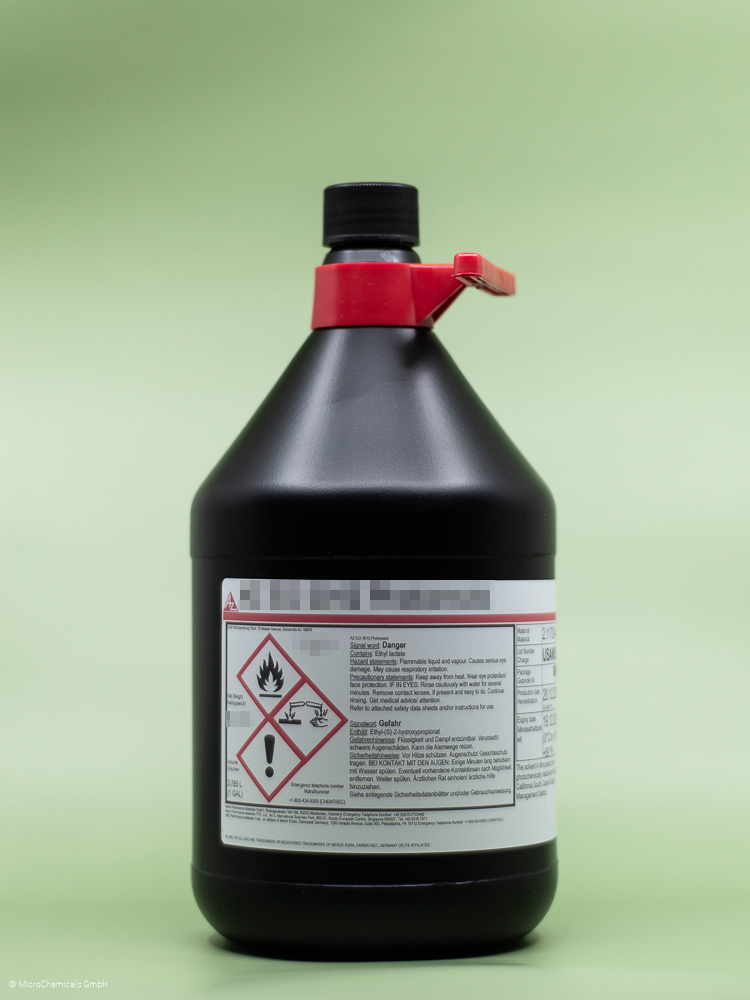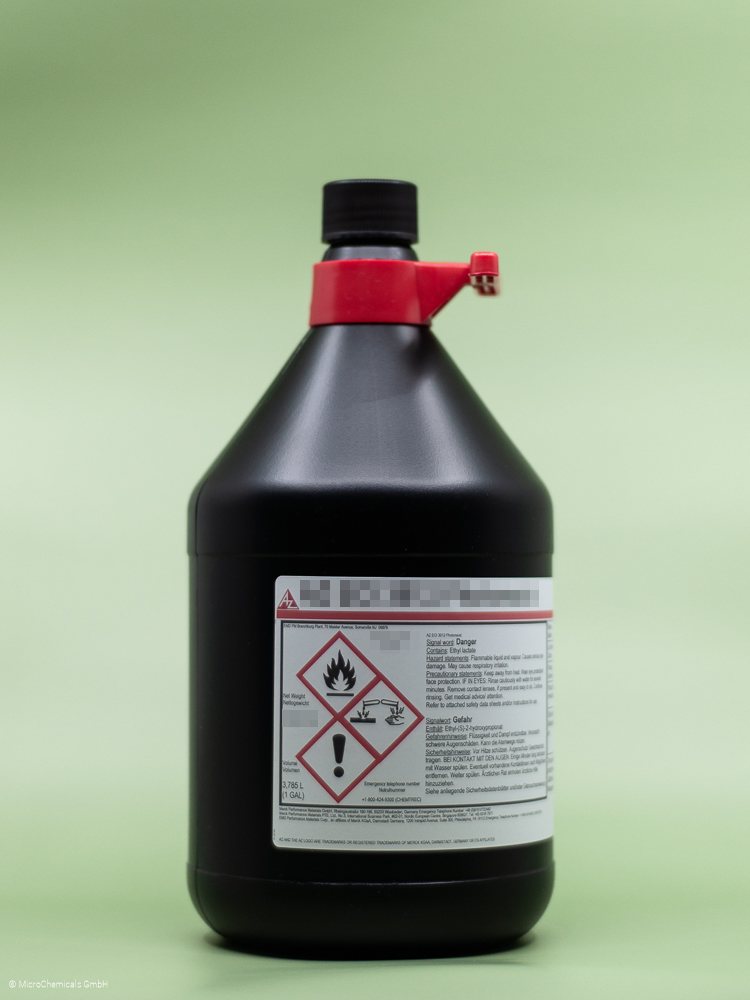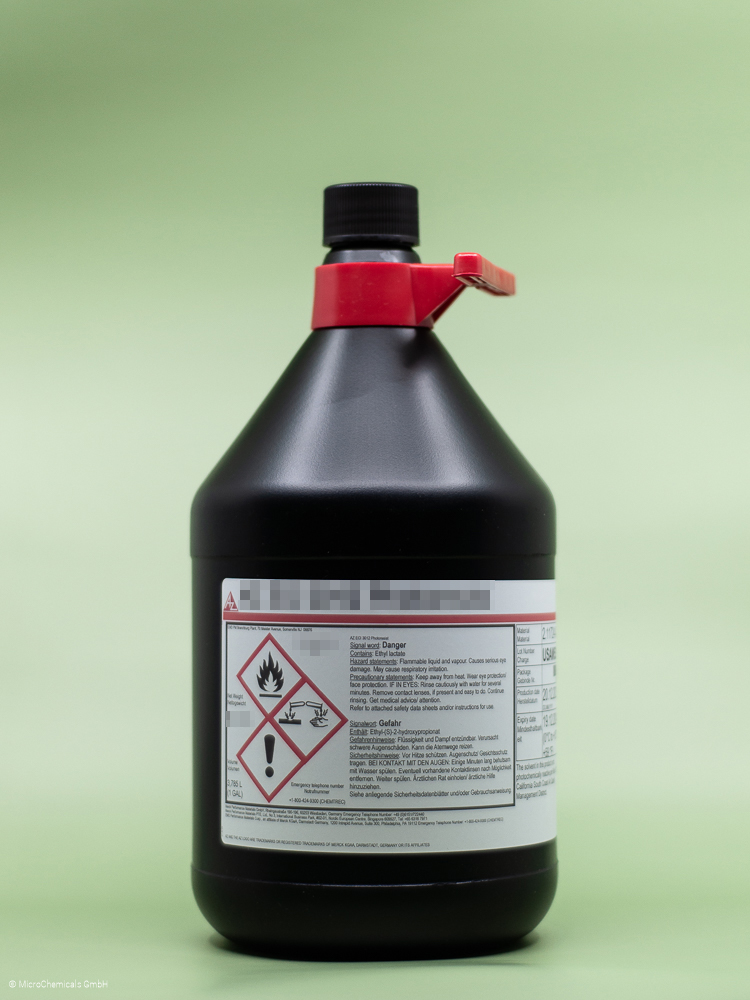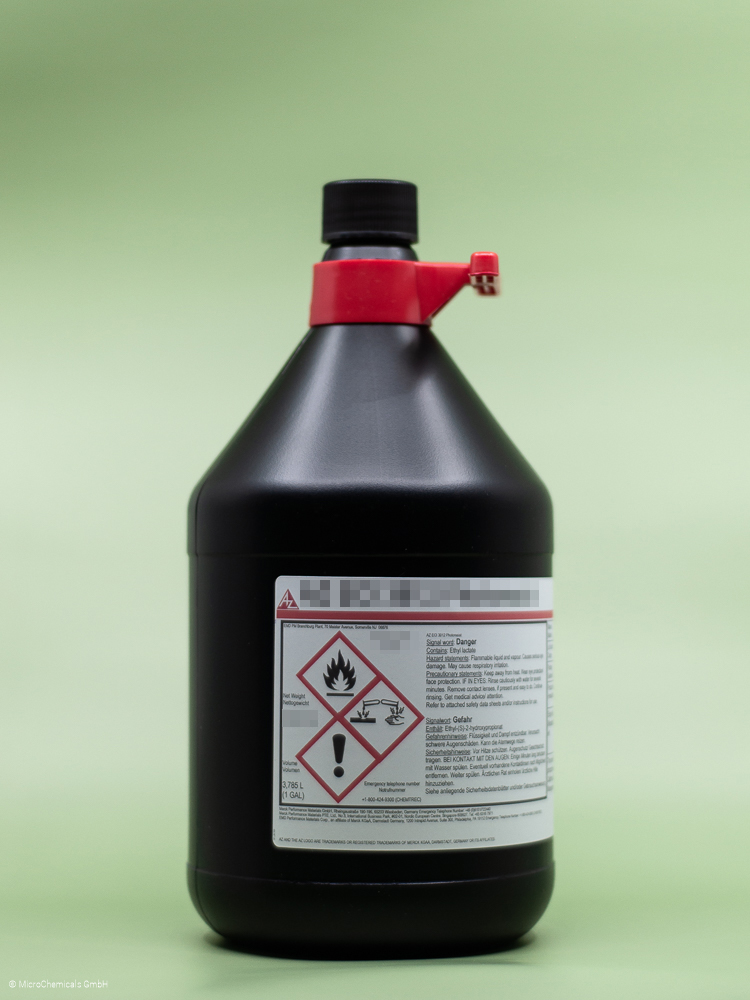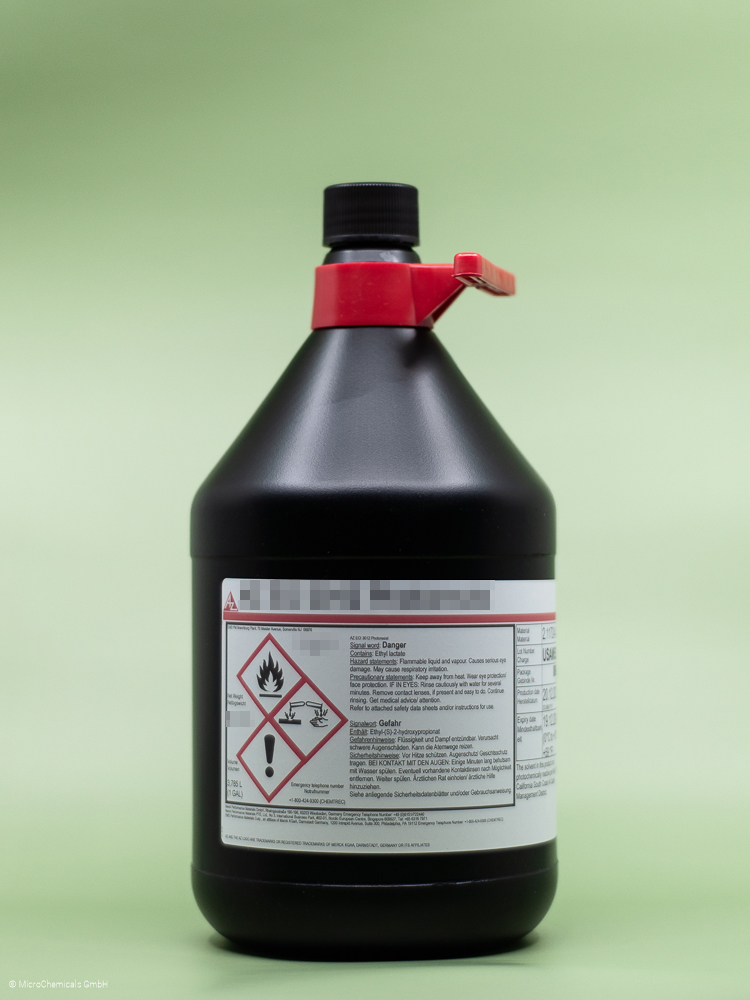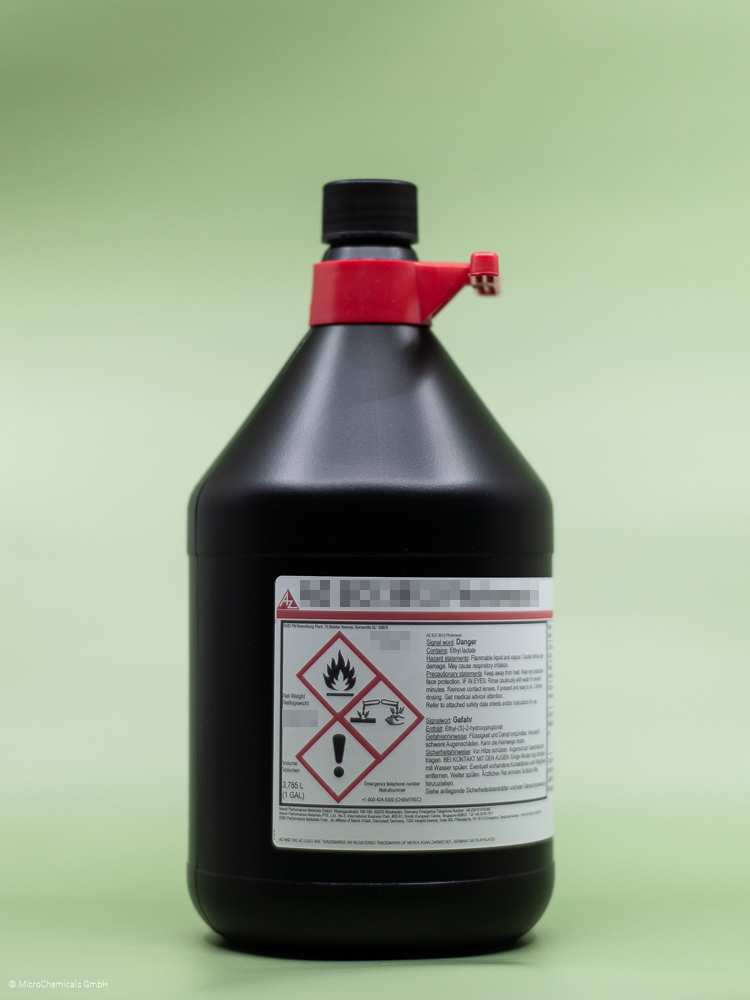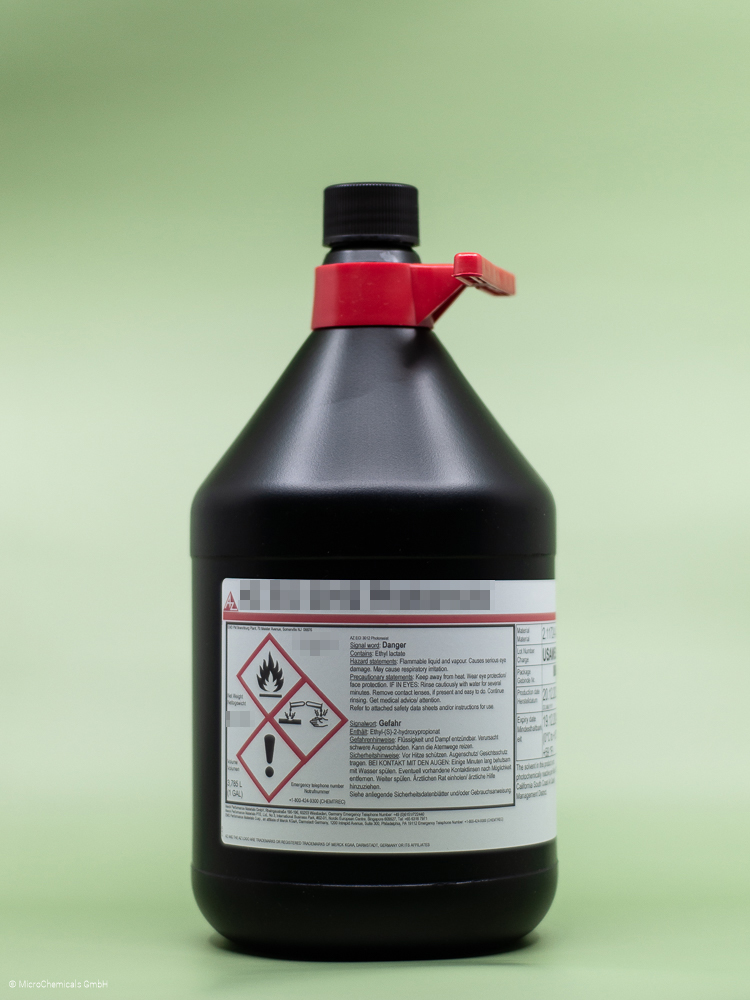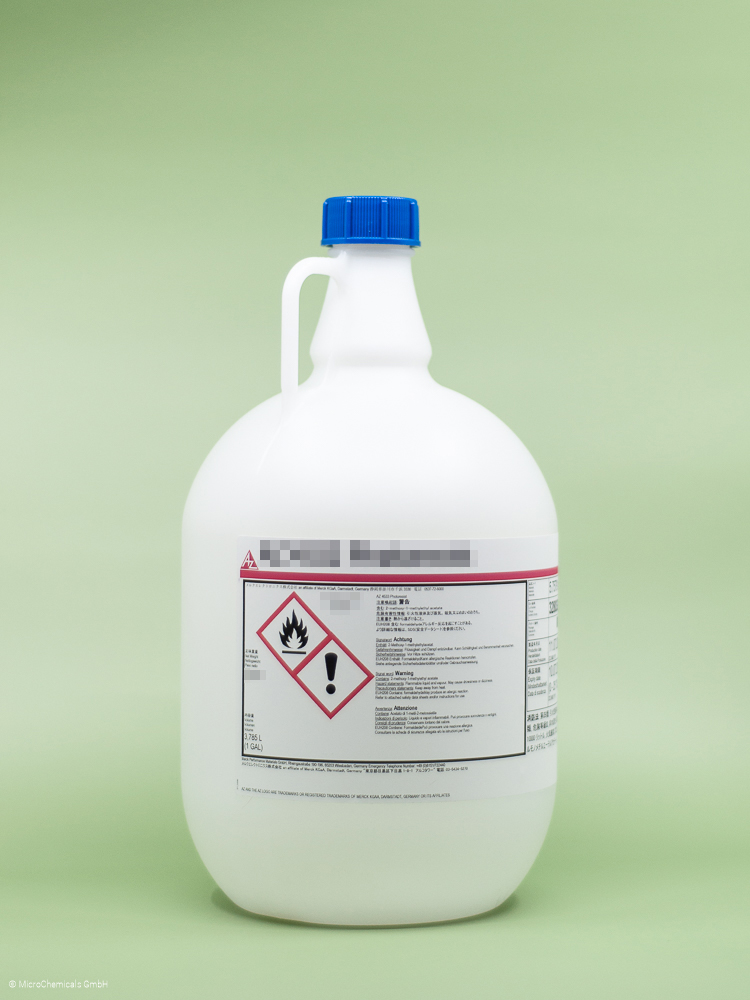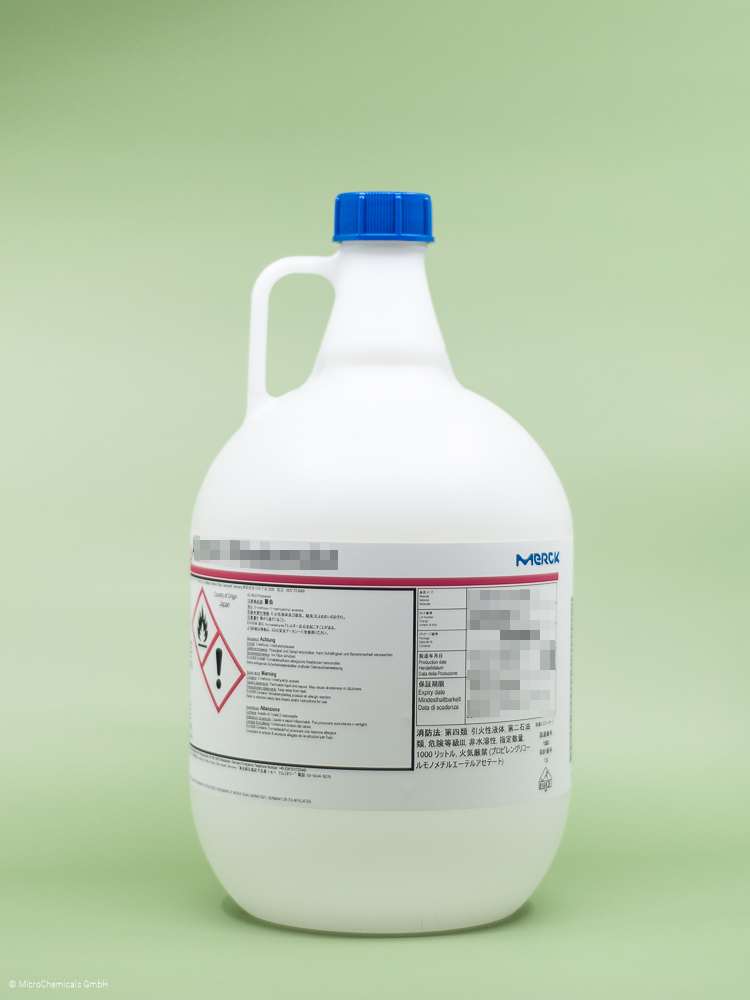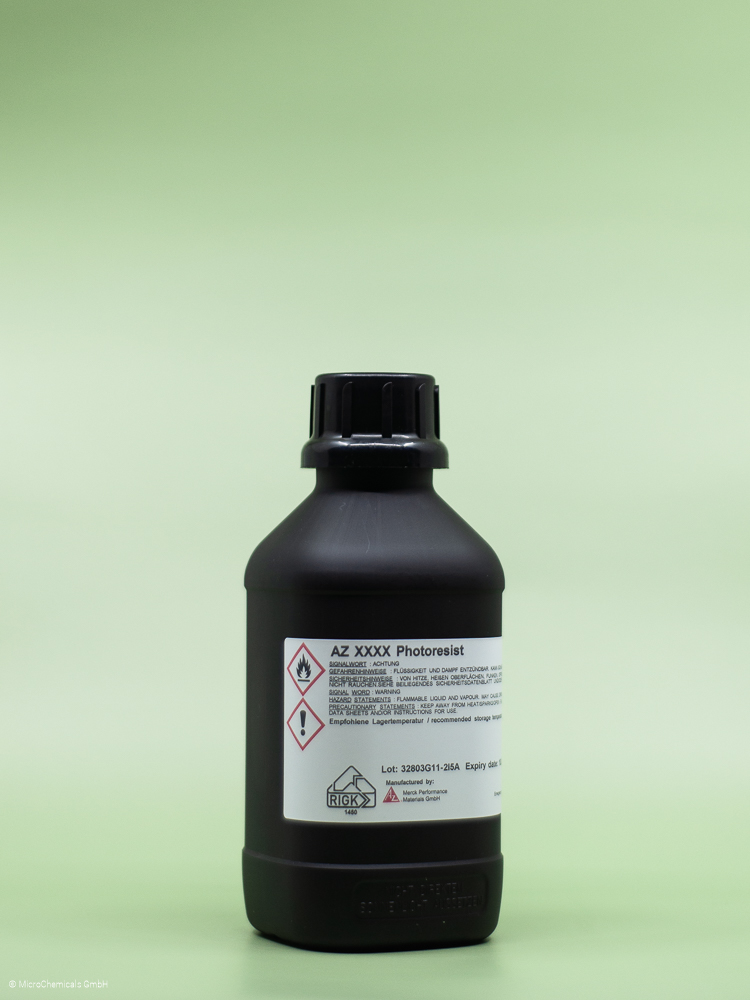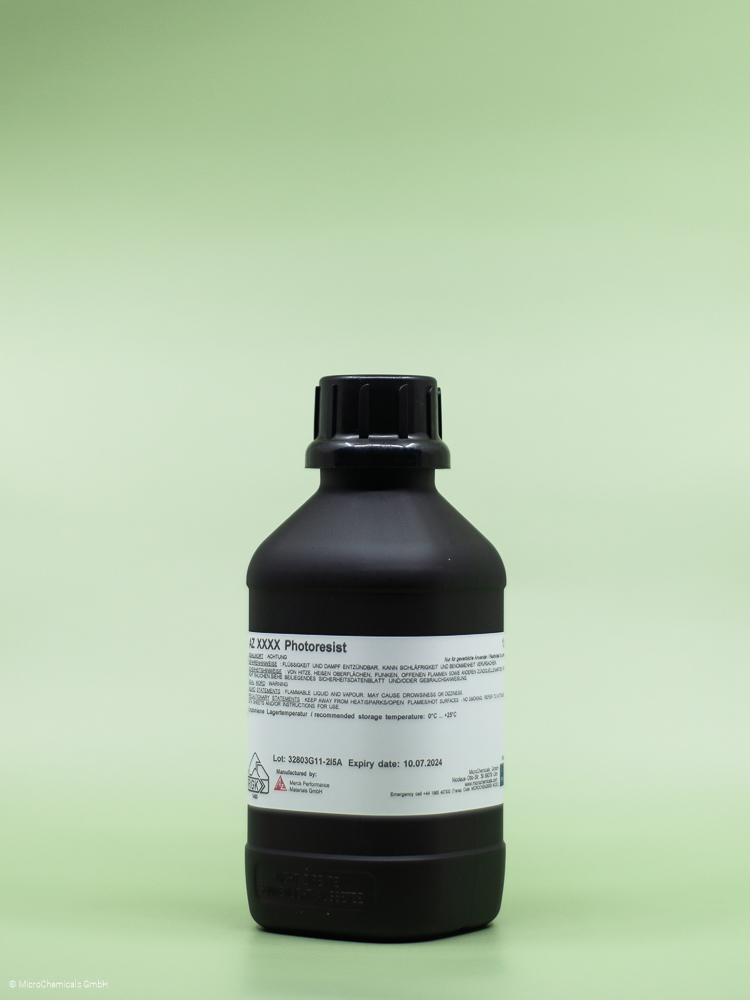SHOP
Filter
–
AZ 351 B Developer - 5.00 l
1000351
AZ® 351B Developer
Inorganic, Metal Ion Containing Developer
General Information
AZ® 351B Developer is a boric acid buffered, NaOH-based developer for non-chemically amplified positive resists.
Product Features
AZ® 351B Developer is a NaOH-based developer, particularly suitable for developing non-chemically amplified positive resists with layer thicknesses of a few µm. AZ® 351B Developer comes as a concentrate and is usually diluted 1: 4 with water. To increase selectivity, a 1: 5 - 1:6 dilution can also be applied, but this significantly reduces the development rate and is therefore not a reasonable option for thicker resist films. If the requirements for steep resist sidewalls are low, the AZ® 351B can also be set stronger (1:3.5 - 1:3) if higher development rates are required , but this leads to a disproportionate increase in dark erosion. AZ® 351B is less suitable for negative resists or chemically amplified positive resists; TMAH-based developers such as the AZ® 326 MIF, AZ® 726 MIF or AZ® 2026 MIF are recommended here. AZ® 351B attacks aluminum with an etching rate of - depending on the concentration of the developer dilution - several 10 nm/min to over 100 nm/min. If this cannot be tolerated, the Al-compatible AZ® Developer can be an alternative.
Further Information
Our safety data sheets and some of our technical data sheets are password-protected.
You will receive the access data after completing the form.
The access data for the data sheets are not your login data from our shop!
MSDS:
Safety Data Sheet AZ® 351B Developer english
Safety Data Sheet AZ® 351B Entwickler german
TDS:
Technical Data Sheet AZ® 351B Developer english
Application Notes:
Development of Photoresist english
Development of Photoresist german
AZ 3DT-102M-15 - 3.785 l
13DT102153
AZ® 3DT-102M-15
Chemically Amplified Positive Photoresist
General Information
AZ® 3DT-102M-15 is a chemically amplified positive tone photoresist with a very high aspect ratio. It is intended for the use as a mask for dry etching, ion implantation, RDL and electroplating applications (Cu-compatible). It can be used with i-line steppers as well as with conventional mask aligners. The AZ® 3DT-102M-15 is intended for a thickness range of 8 - 20 µm.
Product Properties
Steep sidewalls
Compatible with-copper plating-processes
For TSV, implantation, RDL, electroplating, dry etching
Chemically amplified à PEB obligatory
Compatible with most photoresist stripper (e.g. AZ® 100 Remover, organic solvent based or alkaline)
i-line sensitive (can be used for broadband exposure as well)
Resist film thickness range ca. 8 - 20 µm
Developers
The recommended developers are AZ® 326 MIF or AZ® 726 MIF for the photoresist AZ® 3DT-102M-15.
Removers
The recommended strippers for the AZ® 3DT-102M-15 are AZ® 920 Remover, AZ® 100 Remover, TechniStrip P1316, TechniStrip P1331 and TechniStrip MLO07.
Thinning/ Edge Bead Removal
We recommend for thinning the AZ® EBR Solvent.
Further Information
MSDS:
Safety Data Sheet AZ® 3DT-102M-15 Photoresist english
Sicherheitsdatenblatt AZ® 3DT-102M-15 Fotolack german
TDS:
Technical Data Sheet AZ® 3DT-102M-15 Photoresist english
Application Notes:
Further Information about Photoresist Processing
AZ 400 K Dev 1:4 - 5.00 l
1004145
AZ® 400K Developer 1:4
Inorganic, Metal Ion Containing Developer
General Information
AZ® 400K Developer 1:4 is a boric acid buffered, KOH-based ready-to-use developer for non-chemically amplified positive resists.
Product Features
AZ® 400K Developer 1:4 is an AZ® 400K that has already been pre-diluted for use. As a KOH-based developer, this developer is particularly suitable for developing thicker, non-chemically amplified positive resists, but can also be used for thinner resist layers if the resolution requirements are not too high. AZ® 400K Developer is less suitable for negative resists or chemically amplified positive resists; TMAH-based developers such as the AZ® 326 MIF, AZ® 726 MIF or AZ® 2026 MIF are recommended here. AZ® 400K Developer attacks aluminum with an etching rate of - depending on the concentration of the developer dilution - several 10 nm/min to over 100 nm/min. If this cannot be tolerated, the Al-compatible AZ® Developer can be an alternative.
Further Information
Our safety data sheets and some of our technical data sheets are password-protected.
You will receive the access data after completing the form.
The access data for the data sheets are not your login data from our shop!
MSDS:
Safety Data Sheet AZ® 400K 1:4 Developer english
Safety Data Sheet AZ® 400K 1:4 Developer german
TDS:
Technical Data Sheet AZ® 400K 1:4 Developer english
Information AZ® 400K 1:4 Developer english
Application Notes:
Development of Photoresist english
Development of Photoresist german
AZ 400 K Developer - 5.00 l
1000400
AZ® 400K Developer
Inorganic, Metal Ion Containing Developer
General Information
AZ® 400K Developer is a boric acid buffered, KOH-based developer for non-chemically amplified positive resists.
Product Features
As a KOH-based developer, AZ® 400K is particularly suitable for developing thicker, non-chemically amplified positive resists, but can also be used for thinner resist layers if the resolution requirements are not too high. AZ® 400K comes as a concentrate and is usually diluted 1: 4 with water. To increase selectivity, a 1: 5 - 1:6 dilution can also be selected, but this significantly reduces the development rate and is therefore not a reasonable option for thick resist processing. For very thick resist films and/or very steep resist sidewalls are not required, AZ® 400K can also be used at a stronger dilution (1:3.5 - 1:3), which increases the development rate but significantly increases the dark removal. AZ® 400K is less suitable for negative resists or chemically amplified positive resists; TMAH-based developers such as the AZ® 326 MIF, AZ® 726 MIF or AZ® 2026 MIF are recommended here. AZ® 400K attacks aluminum with an etching rate of - depending on the concentration of the developer dilution - several 10 nm/min to over 100 nm/min. If this cannot be tolerated, the Al-compatible AZ® Developer can be an alternative.
Further Information
Our safety data sheets and some of our technical data sheets are password-protected.
You will receive the access data after completing the form.
The access data for the data sheets are not your login data from our shop!
MSDS:
Safety Data Sheet AZ® 400K Developer english
Safety Data Sheet AZ® 400K Developer german
TDS:
Technical Data Sheet AZ® 400K Developer english
Information AZ® 400K Developer english
Application Notes:
Development of Photoresist english
Development of Photoresist german
AZ 40XT-11D Photoresist - 3.785 l
10040XT
Bottle size:
3.785 l
AZ® 40XT
Chemically Amplified Thick Photoresist
General Information
AZ® 40XT is a chemically amplified, i-line sensitive ultra-thick photoresist for high aspect ratios.
Lines and spaces varying from 100 to 10 µm with a 40 µm thick AZ® 40XT at 400 mJ/cm2 exposure dose
Product Features
AZ® 40XT covers a resist film thickness range of approx. 15 - 50 µm. As a chemically amplified resist, the AZ® 40XT does not require rehydration between softbake and exposure, requires significantly lower exposure doses compared to non-chemically amplified resists of comparable thickness, does not release nitrogen during exposure (no bubble formation in the resist film during exposure), and has very high development rates for a thick resist. These properties help to make the entire process significantly faster and less prone to problems than with non-chemically amplified thick resists. Its good adhesion to all common substrate materials and its potential for steep resist sidewalls make it particularly suitable for galvanic molding for e.g. Cu, Ni or Au. In principle, the AZ® 40XT is only sensitive to i-line, but with correspondingly high exposure doses and resist film thicknesses, the h-line (405 nm) can also be used. It should be noted that with these chemically amplified photoresists, the post exposure bake is not optional but mandatory in order to complete the photo reaction induced during exposure and to enable subsequent development. If thinner photoresist layers than approx. 15 µm are desired, the AZ® 40XT can easily be diluted with PGMEA = AZ® EBR Solvent. If bubbles appear in the photoresist layer during the soft bake or post exposure bake, which can occur particularly with thicker photoresist layers, either a slow temperature ramp in these baking processes or a multi-stage baking process with increasing temperatures will help. If these measures are not an option, or if the formation of bubbles cannot be avoided despite this measure, we recommend using the ultra-thick photoresist AZ® IPS 6090, which is also chemically amplified.
Developers
TMAH-based developers such as the ready-to-use AZ® 326 MIF or AZ® 726 MIF are recommended for developing this chemically amplified photoresist. KOH- or NaOH-based developers such as the AZ® 400K or AZ® 351B are less suitable for the AZ® 40XT.
Removers
If the resist structures have not been thermally cross-linked by plasma processes, ion implantation or high temperatures (> approx. 140 °C), all common removers such as AZ® 100 Remover, DMSO or many other organic solvents (e.g. acetone rinsed with isopropanol) are suitable for removing the resist layer. For cross-linked resist structures, high-performance strippers such as the NMP-free TechniStrip P1316 or AZ® 920 Remover are recommended, and in the case of alkaline-sensitive substrate materials (such as aluminum), the TechniStrip MLO 07.
Thinning/ Edge Wall Removal
If the resist is to be diluted for spin coating, PGMEA = AZ® EBR Solvent is an option. PGMEA is the solvent for AZ® 40XT.anyway and is also recommended for edge wall removal if necessary.
Further Information
Our safety data sheets and some of our technical data sheets are password-protected.
You will receive the access data after completing the form.
The access data for the data sheets are not your login data from our shop!
MSDS:
Safety Data Sheet AZ® 40XT Photoresist english
Safety Data Sheet AZ® 40XT Fotolack german
TDS:
Technical Data Sheet AZ® 40XT Photoresist english
Application Notes:
Further Information about Photoresist Processing
AZ 4533 Photoresist - 3.785 l
1A004533
Bottle size:
3.785 l
AZ® 4533
Thick Resists with Optimized Adhesion
General Information
AZ® 4533 belongs to the AZ® 4500 series of positive resists (g-, h- and i-line sensitive) in the medium resist film thickness range, the main application of which is as a resist mask for wet etching or electroplating.
Product Properties
AZ® 4500 resist family is not optimized for very steep resist sidewalls nor for high stability against thermal softening (softening temperature approx. 100 °C), but rather for very high adhesion to all common substrate materials. The low photoinitiator concentration of the AZ® 4500 series resists compared to thin resists (such as the AZ® 1500 series) allows the exposure of even thicker resist layers without the risk of nitrogen bubbles forming in the resist layer.
AZ® 4533 is often used for etching metallic or non-metallic layers. AZ® 4533 achieves a resist film thickness of approx. 3.3 µm at a spin speed of 4000 rpm. With a correspondingly adjusted spin profile, the resist film thickness range of approx. 2.5 - 5 µm can be covered. If thinner resist layers are desired, the use of the AZ® 1500 series is recommended, or a dilution of the AZ® 4533 with PGMEA = "AZ® EBR Solvent". Thicker resist layers can be achieved with the AZ® 4562, which differs from the AZ® 4533 only in the lower solvent content.
Developers
For development, we recommend either TMAH-based developers such as the ready-to-use AZ® 326 MIF or 726 MIF, or the KOH-based AZ® 400K (typically 1:4 diluted with water, for faster development also slightly stronger with 1:3.5 or 1:3). On alkaline-sensitive substrate materials such as aluminum, we recommend the aluminum-compatible, undiluted "AZ® Developer”.
Removers
If the resist structures have not been thermally cross-linked by plasma processes, ion implantation or high temperatures (> approx. 140 °C), all common removers such as AZ® 100 Remover, DMSO or many other organic solvents (e.g. acetone rinsed with isopropanol) are suitable for removing the resist layer. For cross-linked resist structures, high-performance strippers such as the NMP-free TechniStrip P1316or AZ® 920 Remover are recommended, and in the case of alkaline-sensitive substrate materials (such as aluminum), the TechniStrip MLO 07.
Thinning/ Edge Bead Removal
If the resist is to be diluted for spin coating, PGMEA = AZ® EBR Solvent is the recommended solvent. PGMEA is the solvent for AZ® 4533 anyway and is also recommended for edge wall removal if necessary.
Further Information
Our safety data sheets and some of our technical data sheets are password-protected.
You will receive the access data after completing the form.
The access data for the data sheets are not your login data from our shop!
MSDS:
Safety Data Sheet AZ® 4533 Photoresist english
Safety Data Sheet AZ® 4533 Photoresist german
TDS:
Technical Data Sheet AZ® 4533 Photoresist english
Application Notes:
Further Information about Photoresist Processing
AZ 4562 Photoresist - 3.785 l
1A004562
Bottle size:
3.785 l
AZ® 4562
Thick Resists with Optimized Adhesion
General Information
AZ® 4562 belongs to the AZ® 4500 series of positive resists (g-, h- and i-line sensitive) in the medium to high resist film thickness range, the main application of which is as a resist mask for wet etching or electroplating.
Product Properties
AZ® 4500 resist family is not optimized for very steep resist sidewalls nor for high stability against thermal softening (softening temperature approx. 100 °C), but rather for very high adhesion to all common substrate materials. The low photoinitiator concentration of the AZ® 4500 series resists compared to thin resists (such as the AZ® 1500 series) allows the exposure of even thicker resist layers without the risk of nitrogen bubbles forming in the resist layer.
AZ® 4562 is often used in electroplating or for etching metallic or non-metallic layers. AZ® 4562 achieves a resist film thickness of approx. 6 µm at a spin speed of 4000 rpm. With an appropriately adjusted spin profile, the resist film thickness range of approx. 4.5 - 20 µm can be covered. If thinner resist films are required, the AZ® 4533 is recommended, which differs from the AZ® 4562 only in the higher solvent content. From approx. 10 µm, processing the AZ® 4562 becomes increasingly time-consuming: the soft bake and subsequent development take longer, rehydration between the soft bake and exposure requires more and more time, and there is also the risk of nitrogen bubbles forming during exposure. For resist film thicknesses greater than 10-20 µm, it is recommended to consider using a chemically amplified thick resist such as AZ® 12 XT (5 -20 µm resist film thickness) or IPS 6090 (> 20 µm resist film thickness), which have significantly shorter softbake and development times at the corresponding resist thickness and do not require rehydration and significantly lower exposure doses.
Developers
For development, we recommend either TMAH-based developers such as the ready-to-use AZ® 326 MIF or 726 MIF, or the KOH-based AZ® 400K (typically 1:4 diluted with water, for faster development also slightly stronger with 1:3.5 or 1:3). On alkaline-sensitive substrate materials such as aluminum, we recommend the aluminum-compatible, undiluted AZ® Developer.
Removers
If the resist structures have not been thermally cross-linked by plasma processes, ion implantation or high temperatures (> approx. 140 °C), all common removers such as AZ® 100 Remover, DMSO or many other organic solvents (e.g. acetone rinsed with isopropanol) are suitable for removing the resist layer. For cross-linked resist structures, high-performance strippers such as the NMP-free TechniStrip P1316 or AZ® 920 Remover are recommended, and in the case of alkaline-sensitive substrate materials (such as aluminum), the TechniStrip MLO 07**.
Thinning/ Edge Bead Removal
If the resist is to be diluted for spin coating, PGMEA = AZ® EBR Solvent is the recommended solvent. PGMEA is the solvent for AZ® 4562 anyway and is also recommended for edge removal if necessary.
Further Information
Our safety data sheets and some of our technical data sheets are password-protected.
You will receive the access data after completing the form.
The access data for the data sheets are not your login data from our shop!
MSDS:
Safety Data Sheet AZ® 4562 Photoresist english
Safety Data Sheet AZ® 4562 Photoresist german
TDS:
Technical Data Sheet AZ® 4562 Photoresist english
Application Notes:
Further Information about Photoresist Processing
AZ 4999 Photoresist - 3.785 l - EUD/EVE!
1A004999
Bottle size:
3.785 l
AZ® 4999
Spray Coating
General Information
AZ®4999 is a spray coating dedicated highly transparent photoresist tailored to excel on special spray coating equipment (e.g. SUSS Delta AltaSpray) where it provides defect free and conformal coatings on devices with severe topography. Thick (several to several tens of microns) and uniform resist coatings are obtained on topography such as V-grooves and trenches with optimum coverage of sharp edges. There is no accumulation of resist in trenches. The use of AZ®4999 photoresist enables high reproducibility in volume production applications.
Product Properties
Viscosity (at 25°C): 0.52 cSt
Solids content: 4 %
Absorptivity at 398 nm: 0.1 l/(g*cm)
Spectral sensitivity: 310 nm – 440 nm
Developers
If metal ion containing developers can be used, the KOH-based AZ® 400K in a 1:4 dilution (for higher resist film thicknesses 1:3.5 - 1:3 diluted possible) is a suited developer.
If metal ion free developers have to be used, we recommend the TMAH-based AZ® 2026 MIF developer (undiluted).
Removers
For non cross-linked resist films the AZ® 100 Remover, DMSO or other common organic solvents cab be used as stripper. If the resist film is crosslinked (e. g. by high temperature steps > 140°C, during plasma processes such as dry etching, or during ion implantation), we recommend the NMP-free TechniStrip P1316 as remover. AZ® 920 Remover can be a good choice as well, in case of harsh treated, hard to remove resist residuals.
Thinning/ Edge Bead Removal
We recommend for thinning and edge bead removal the products AZ® EBR Solvent or PGMEA.
Further Information
MSDS:
Safety Data Sheet AZ® 4999 Photoresist english
Sicherheitsdatenblatt AZ® 4999 Fotolack german
TDS:
Technical Data Sheet AZ® 4999 Photoresist english
Application Notes:
Further Information about Photoresist Processing
AZ 5209-E Photoresist - 3.785 l
1A005209
AZ® 5209E
Image Reversal Resist for High Resolution
General Information
This special photoresist is the thinner version of the AZ® 5200E series intended for lift-off techniques which call for a negative side wall profile. The reversal bake moderately cross-links the exposed resist making the developed structures thermally stable up to approx. 130°C. Due to the comparably low resist film thickness of ~ 0.9 µm, the process parameter window for an undercut is rather small thus requiring some optimizations in the exposure dose and the reversal bake parameters. Therefore, if the resolution required is not in the sub-µm range, a thicker resist such as the AZ® LNR-003 (next section), or the AZ® nLOF 2000 negative resists might be a good alternative.
Product Properties
Very high resolution as a positive resist as well as a negative resist
Possible negative sidewall profile in image reversal mode
Compatible with all common developers (NaOH-, KOH- or TMAH-based)
Compatible with all common strippers (e. g. with AZ® 100 Remover, organic solvents, or aqueous alkaline)
h- and i-line sensitive (approx. 320 - 405 nm)
Resist film thickness range approx. 0.7 - 1.2 µm
High thermal stability especially in image reversal mode
Developers
If metal ion containing developers can be used, the NaOH-based AZ® 351B in a 1:4 dilution (for a required resolution < 1 µm 1:5 dilution recommended) is a suited developer.
The KOH-based AZ® 400K (also 1:4 - 1:5 diluted) is also possible.
If metal ion free developers have to be used, we recommend the TMAH-based AZ® 726 MIF or AZ® 326 MIF developer, normally undiluted, or - for maximum resolution - moderately 3:1 - 2:1 (3 parts Developer :1 part of DI-Water) diluted with water.
Removers
For non cross-linked resist films the AZ® 100 Remover, DMSO or other common organic solvents cab be used as stripper. If the resist film is crosslinked (e. g. by high temperature steps > 140°C, during plasma processes such as dry etching, or during ion implantation), we recommend the NMP-free TechniStrip P1316 as remover. AZ® 920 Remover can be a good choice as well, in case of harsh treated, hard to remove resist residuals.
Thinning/ Edge Bead Removal
We recommend for thinning and edge bead removal the products AZ® EBR Solvent or PGMEA.
Further Information
MSDS:
Safety Data Sheet AZ® 5209-E Photoresist english
Sicherheitsdatenblatt AZ® 5209-E Fotolack german
TDS:
Technical Data Sheet AZ® 5209-E Photoresist english
Application Notes:
Further Information about Photoresist Processing
AZ 5214-E Photoresist - 3.785 l
1005214EJP
Bottle size:
3.785 l
AZ® 5214E
Image Reversal Resist for High Resolution
General Information
This special photoresist is intended for lift-off techniques which call for a negative side wall profile. The reversal bake moderately cross-links the exposed resist making the developed structures thermally stable up to approx. 130°C. Due to the comparably low resist film thickness of ~1.4 µm, the process parameter window for an undercut is rather small thus requiring some optimizations in the exposure dose and the reversal bake parameters. Therefore, if the resolution required is not in the sub-µm range, a thicker resist such as the AZ® LNR-003 (next section), or the AZ® nLOF 2000 negative resists might be a good alternative.
The undercut of AZ® 5214E attained under optimized process parameters.
Product Properties
Very high resolution as a positive resist as well as a negative resist
Possible negative sidewall profile in image reversal mode
Compatible with all common developers (NaOH-, KOH- or TMAH-based)
Compatible with all common strippers (e. g. with AZ® 100 Remover, organic solvents, or aqueous alkaline)
h- and i-line sensitive (approx. 320 - 405 nm)
Resist film thickness range approx. 1.0 – 1.8 µm
High thermal stability especially in image reversal mode
Developers
If metal ion containing developers can be used, the NaOH-based AZ® 351B in a 1:4 dilution (for a required resolution < 1 µm 1:5 dilution recommended) is a suited developer.
The KOH-based AZ® 400K (also 1:4 - 1:5 diluted) is also possible.
If metal ion free developers have to be used, we recommend the TMAH-based AZ® 726 MIF or AZ® 326 MIF developer, normally undiluted, or - for maximum resolution - moderately 3:1 - 2:1 ( 3 parts Developer :1 part of DI-Water) diluted with water.
Removers
For non cross-linked resist films the AZ® 100 Remover, DMSO or other common organic solvents cab be used as stripper. If the resist film is crosslinked (e. g. by high temperature steps > 140°C, during plasma processes such as dry etching, or during ion implantation), we recommend the NMP-free TechniStrip P1316 as remover. AZ® 920 Remover can be a good choice as well, in case of harsh treated, hard to remove resist residuals.
Thinning/ Edge Bead Removal
We recommend for thinning and edge bead removal the products AZ® EBR Solvent or PGMEA.
Further Information
MSDS:
Safety Data Sheet AZ® 5214E Photoresist english
Sicherheitsdatenblatt AZ® 5214E Fotolack german
TDS:
Technical Data Sheet AZ® 5214E Photoresist english
Application Notes:
Further Information about Photoresist Processing
AZ 726 MIF Developer - 5.00 l
1000726
AZ® 726 MIF Developer
Metal Ion-free Developers
General Information
AZ® 726 MIF is a TMAH-based developer for dip or puddle development, compatible with all AZ® photoresists from our portfolio.
Product Features
The ready-to-use AZ® 726 MIF Developer is an aqueous 2.38% TMAH solution with a surfactant for even substrate wetting for puddle development, but is also suitable for immersion development. For spray development, the surfactant-free AZ® 326 MIF would be the better choice to avoid foaming. TMAH-based developers are always used when metal ion-free development is required. In addition, TMAH-based developers are primarily recommended for our chemically amplified positive resists and our negative resists. For standard (non chemically amplified), DNQ-based positive resists without the requirement for metal ion-free development, a KOH or NaOH-based developer such as AZ® 400K or AZ® 351B can be considered instead of a TMAH-based developer for cost reasons. For cross-linking negative resists, the AZ® 2026 MIF can prove to be advantageous, as it promotes residue-free development with these resists thanks to certain additives. For very thin resist layers (< 1 µm) or very high resolution requirements, it can be useful to dilute the AZ® 726 MIF Developer with water (AZ® 726 MIF: water = 2:1 to a maximum of 1:1). AZ® 726 MIF attacks aluminum with an etching rate of approx. 70 nm/min. If this cannot be tolerated, the Al-compatible AZ® Developer is an alternative, but this is based on sodium compounds and is therefore not free of metal ions.
Further Information
Our safety data sheets and some of our technical data sheets are password-protected.
You will receive the access data after completing the form.
The access data for the data sheets are not your login data from our shop!
MSDS:
Safety Data Sheet AZ® 726 MIF Developer english
Safety Data Sheet AZ® 726 MIF Entwickler german
TDS:
Technical Data Sheet AZ® 726 MIF Developer english
Application Notes:
Development of Photoresist english
Development of Photoresist german
AZ AQUATAR-VIII-A 45 - 0.25 l
1008A4502
Bottle size:
0.25 l
AZ Aquatar ®-VIII A 45
Antireflective Coating
General Information
AZ® Aquatar -VIII A45 is a top layer anti-reflective coating for use with g- and i-line. AZ® Aquatar -VIII A45 acts like an optical coating at the interface photoresist/air and improves image contrast.
Multiple reflections within the photoresist are also suppressed, the result is generally a reduction of the amplitude of the swing curve to 1/3rd. Application is very simple: it is just spun on top of the photoresist, no additional bake cycle is required and the standard development cycle removes it.
This simple process reduces line width variation over topography significantly, however does not suppress reflective notching.
Product Properties
AZ® Aquatar -VIII A45 top anti-reflective coating is an aqueous material for use with positive photoresists in the semiconductor industry. The effect of the anti-reflective coating is to dramatically reduce the amplitude of the resist swing curve. When optimized this change in swing curve amplitude can be up to a factor of three times reduction. Optimum film thickness can be calculated using the following function:
Film thickness = lambda : 4n
lambda = wavelength of exposure light
n = refractive index of AZ® Aquatar
After exposure AZ® Aquatar top anti-reflective coating is removed using either a water rinse or the aqueous positive resist developer itself. As soon as the anti-reflective coating is removed the resist will develop as normal. An optimized process is confirmed when the original resist swing curve is seen to be exactly 180° out of phase with the modified swing curve derived from the use of AZ® Aquatar top anti-reflective coating. When this is not the case, there will still be a significant swing curve reduction but not to the same extent as a fully optimized process. When used with AZ® i-line photoresists, image bias, usually seen as a difference in dimension between dense and isolated lines is dramatically reduced to values close to 0 %. A top anti-reflective coating will not reduce reflective notching caused by exposing light being reflected from the substrate. For this process situation a bottom anti-reflective coating, AZ® Aquatar, AZ® Barli, is recommended.
Developers
All aqueous alkaline developers.
Removers
Not required, water soluble.
Thinning/ Edge Bead Removal
Not required, water soluble.
Further Information
MSDS:
Safety Data Sheet AZ® Aquatar -VIII A45 Photoresist english
Sicherheitsdatenblatt AZ® Aquatar -VIII A45 Fotolack german
TDS:
Technical Data Sheet AZ® Aquatar Photoresist english
Technical Data Sheet AZ® Aquatar TARC english
Info AZ® Aquatar EN
Application Notes:
Further Information about Photoresist Processing
AZ Barli II 200 - 0.25 l
10255002
Bottle size:
0.25 l
AZ ® BARLiTM II 200
Antireflective Coating
General Information
AZ® BARLiTM II is a bottom antireflective layer coating for use on highly reflective surfaces in the semiconductor industry. It is designed to work with as antireflective layer between photoresist and substrate and is optimized for i-line exposure tools. Upon completion of the lithographic process, AZ® BARLiTM II is patterned in a dry-etch process.
Product Properties
AZ®BARLiTM II coating material is formulated in photoresist-compatible solvents to simplify the EBR process and to be both environmental and user friendly. AZ®BARLiTM II is tailor-made to yield the near-optimum values for refractive indices (n and k) for i-line lithography, which ensures minimum reflectivity and maximum swing reduction for photoresist layers. Composed of highly absorptive polymer-bound dyes, this material provides excellent coating uniformity and step coverage.
AZ®BARLiTM II shows high etch selectivity (comparable to AZ®BARLiTM) and high thermal stability up to 230°C. It does not show intermixing with photoresist when the bake temperature is higher than 180°C.
AZ®BARLiTM II is available in two thickness grades, 900 A and 2000 A, in order to provide optimum film thickness for the first and the second swing minimum respectively at about 3000 rpm spin speed.
Developers
No restriction.
Removers
Dry Etching.
Edge Bead Removal
We recommend AZ® EBR 70/30 for edge bead removal for best performance.
Further Information
MSDS:
Safety Data Sheet AZ®BARLiTM II 200 Photoresist english
Sicherheitsdatenblatt AZ®BARLiTM II 200 Fotolack german
TDS:
Technical Data Sheet AZ®BARLiTM II Photoresist english
Info AZ®BARLiTM II Photoresist english
Info AZ®BARLiTM II Processing english
Application Notes:
Further Information about Photoresist Processing
AZ Barli II 90 - 3.785 l
1002550
AZ ® BARLiTM II 90
Antireflective Coating
General Information
AZ® BARLiTM II is a bottom antireflective layer coating for use on highly reflective surfaces in the semiconductor industry. It is designed to work with as antireflective layer between photoresist and substrate and is optimized for i-line exposure tools. Upon completion of the lithographic process, AZ® BARLiTM II is patterned in a dry-etch process.
Product Properties
AZ®BARLiTM II coating material is formulated in photoresist-compatible solvents to simplify the EBR process and to be both environmental and user friendly. AZ®BARLiTM II is tailor-made to yield the near-optimum values for refractive indices (n and k) for i-line lithography, which ensures minimum reflectivity and maximum swing reduction for photoresist layers. Composed of highly absorptive polymer-bound dyes, this material provides excellent coating uniformity and step coverage.
AZ®BARLiTM II shows high etch selectivity (comparable to AZ®BARLiTM) and high thermal stability up to 230°C. It does not show intermixing with photoresist when the bake temperature is higher than 180°C.
AZ®BARLiTM II is available in two thickness grades, 900 A and 2000 A, in order to provide optimum film thickness for the first and the second swing minimum respectively at about 3000 rpm spin speed.
Developers
No restriction.
Removers
Dry Etching.
Edge Bead Removal
We recommend AZ® EBR 70/30 for edge bead removal for best performance.
Further Information
MSDS:
Safety Data Sheet AZ®BARLiTM II 90 Photoresist english
Sicherheitsdatenblatt AZ®BARLiTM II 90 Fotolack german
TDS:
Technical Data Sheet AZ®BARLiTM II Photoresist english
Info AZ®BARLiTM II Photoresist english
Info AZ®BARLiTM II Processing english
Application Notes:
Further Information about Photoresist Processing
AZ Developer - 5.00 l
1000001
AZ® Developer
Inorganic, Metal Ion Containing Developer
General Information
AZ® Developer is a sodium salt-based, aluminum-compatible developer for non-chemically amplified positive resists.
Product Features
AZ® Developer is based on an aqueous Sodium metasilicate/Sodium phosphate solution. In contrast to NaOH, KOH or TMAH-based developers, this developer does not show any significant aluminum attack and is suitable for the development of non-chemically amplified positive resists. For thicker resist layers or when the requirements for resolution and steepness of the resist sidewalls are not too high, the AZ® Developer can be used undiluted. For thin resists and higher resolution requirements, it can be diluted 1:1 with water. An AZ® Developer: Water = 2:1 dilution represents a good compromise for many applications. For negative resists or chemically amplified positive resists, the AZ® Developer usually does not show satisfactory results. TMAH-based developers are recommended for these, but these are not aluminum compatible.
Further Information
Our safety data sheets and some of our technical data sheets are password-protected.
You will receive the access data after completing the form.
The access data for the data sheets are not your login data from our shop!
MSDS:
Safety Data Sheet AZ® Developer english
Safety Data Sheet AZ® Developer german
TDS:
Technical Data Sheet AZ® Developer english
Application Notes:
Development of Photoresist english
Development of Photoresist german
AZ Developer 1:1 - 5.00 l
1000115
AZ® Developer 1:1
Inorganic Developers
General Information
AZ® Developer 1:1 is a ready-to-use product and is a 1:1 dilution of AZ Developer. The developer is optimized for minimum Al attack. It is an odourless, aqueous, inorganic, alkaline solution, which is compatible with batch and in-line developing processes. AZ® Developer 1:1 is for high contrast. The dark erosion of AZ® Developer 1:1 is slightly higher as compared to other developers. AZ® Developer 1:1 can be used in combination with most families of AZ® Photoresists (i.e. AZ® 1500, AZ® ECI3000 and AZ® 4500 or AZ® PL177). AZ® Developer 1:1 displays the lowest aluminium etch rate (it is more or less zero!) of all AZ® Developer 1:1 types and is ideal for metal levels.
Further Information
MSDS:
Safety Data Sheet AZ® Developer 1:1 english
Sicherheitsdatenblatt AZ® Developer 1:1 german
TDS:
Technical Data Sheet AZ® Developer 1:1 english
Application Notes:
Development of Photoresist english
Entwicklung von Fotolack german
AZ EBR 70/30 - 1.00 l
10703021
Bottle size:
1.00 l
AZ® EBR Solvent 70/30
1-methoxy-2-propyl-acetate
General Information
AZ® EBR Solvent 70/30 is the main solvent/thinner of almost all AZ® and TI photoresists due to its low vapour pressure and its suppression of particle formation in the (further diluted) resist. Additionally, PGMEA is often used for edge bead removal, since its low vapour pressure prevents further thinning of the coated resist film.
Product Properties
Density: 0.97 g/cm3
Melting point: -66°C
Boiling point: 125°C
Flash point: 45°C
Vapour pressure @ 20°C: 5 hPa
PGMEA Molecule
Further Information
MSDS:
Safety Data Sheet AZ® EBR Solvent 70/30 english
Sicherheitsdatenblatt AZ® EBR Solvent 70/30 german
TDS:
Technical Data Sheet AZ® EBR Solvent 70/30 english
Information AZ® EBR Solvent 70/30 english
AZ EBR Solvent - 5.00 l
1000002
Bottle size:
5.00 l
AZ® EBR Solvent
1-methoxy-2-propyl-acetate
General Information
AZ® EBR Solvent is the main solvent/thinner of almost all AZ® and TI photoresists due to its low vapour pressure and its suppression of particle formation in the (further diluted) resist. Additionally, PGMEA is often used for edge bead removal, since its low vapour pressure prevents further thinning of the coated resist film.
Product Properties
Density: 0.97 g/cm3
Melting point: -66°C
Boiling point: 125°C
Flash point: 45°C
Vapour pressure @ 20°C: 5 hPa
PGMEA Molecule
Further Information
MSDS:
Safety Data Sheet AZ® EBR Solvent english
Sicherheitsdatenblatt AZ® EBR Solvent german
TDS:
Technical Data Sheet AZ® EBR Solvent english
AZ ECI 3007 Photoresist - 3.785 l
1A003007
Bottle size:
3.785 l
AZ® ECI 3007
High Resolution with Broad Process Window
General Information
AZ® ECI 3007 belongs to the AZ® ECI 3000 series of positive thin resists (g-, h- and i-line sensitive), whose main applications are as a resist mask for dry etching, RIE, ion implantation or lift-off processes.
Product Properties
AZ® ECI 3000 resist family is optimized for steep resist sidewalls and high stability against thermal softening (softening temperature approx. 125 °C). AZ® ECI 3000 resists require a significantly lower exposure dose compared to other positive resists, but still develop quickly.
AZ® ECI 3007 is the thinnest member of this resist series with a resist film thickness of approx. 700 nm at 3000 rpm. This resist is often used for dry etching, RIE or lift-off processes and, under optimized process parameters, allows a resolution well in the sub-micrometer range. If such a high resolution is not required, a slightly thicker resist from this series (for example AZ® ECI 3012, AZ® ECI 3027) can be useful. If necessary, the AZ® ECI 3007 can easily be further diluted with PGMEA = AZ® EBR Solvent. Paints from the AZ® 1500 or 4500 series are recommended for applications with high requirements for very good resist adhesion such as wet etching and galvanic deposition.
Developers
For development, we recommend either TMAH-based developers such as AZ® 326 MIF or AZ® 726 MIF, the NaOH-based AZ® 351B, and if the requirements for selectivity are not too high, the KOH-based AZ® 400K. With AZ® 351B or AZ® 400K, it may be advisable to work with a higher diluted developer (for example 1:5 to 1:6) instead of the usual 1: 4 dilution to achieve very fine resist structures or better controllable development times. On alkaline-sensitive substrate materials such as aluminum, we recommend the aluminum-compatible AZ® Developer in a 1:1 dilution.
Removers
If the resist structures have not been thermally cross-linked by plasma processes, ion implantation or high temperatures (> approx. 140 °C), all common removers such as AZ® 100 Remover, DMSO or many other organic solvents (e.g. acetone rinsed with isopropanol) are suitable for removing the resist layer. For cross-linked resist structures, high-performance strippers such as the NMP-free TechniStrip P1316 or AZ® 920 Remover are recommended, and in the case of alkaline-sensitive substrate materials (such as aluminum), the TechniStrip MLO 07.
Thinning/ Edge Bead Removal
PGMEA = AZ® EBR Solvent can generally be used as a thinner for spin coating, which can also be used to remove edge ridges if necessary.
Further Information
Our safety data sheets and some of our technical data sheets are password-protected.
You will receive the access data after completing the form.
The access data for the data sheets are not your login data from our shop!
MSDS:
Safety Data Sheet AZ® ECI 3007 Photoresist english
Safety Data Sheet AZ® ECI 3007 Photoresist german
TDS:
Technical Data Sheet AZ® ECI 3000 Series english
Application Notes:
Further Information about Photoresist Processing
AZ ECI 3012 Photoresist - 3.785 l
1A003012
Bottle size:
3.785 l
AZ® ECI 3012
High Resolution with Broad Process Window
General Information
AZ® ECI 3012 belongs to the AZ® ECI 3000 series of positive thin resists (g-, h- and i-line sensitive), whose main applications are as a resist mask for dry etching, RIE, ion implantation or lift-off processes.
450 nm resist lines with the AZ® ECI 3012 at approx. 1.2 µm film thickness.
Product Properties
AZ® ECI 3000 resist family is optimized for steep resist sidewalls and high stability against thermal softening (softening temperature approx. 125 °C). AZ® ECI 3000 resists require a significantly lower exposure dose compared to other positive resists, but still develop quickly. AZ® ECI 3012 covers the resist film thickness range of approx. 1.3 µm at 3000 rpm with adapted spin profiles. This resist is often used for dry etching, RIE or lift-off processes and allows a resolution in the sub-micrometer range under optimized process parameters. If such a high resolution is not required, a slightly thicker resist from this series (for example AZ® ECI 3027) can be useful. If thinner resist layers are required, we recommend AZ® ECI 3007, or alternatively a dilution of AZ® ECI 3012 with PGMEA = AZ® EBR Solvent. For applications with high requirements for very good resist adhesion, such as wet etching and galvanic deposition, we recommend resists from the AZ® 1500 or 4500 series.
Developers
For development, we recommend either TMAH-based developers such as AZ® 326 MIF, or 726 MIF, the NaOH-based AZ® 351B, and if the requirements for selectivity are not too high, the KOH-based AZ® 400K. with AZ® 351B or AZ® 400K, it may be advisable to work with a higher diluted developer (for example 1:5 to 1:6) instead of the usual 1: 4 dilution to achieve very fine resist structures or better controllable development times. On alkaline-sensitive substrate materials such as aluminum, we recommend the aluminum-compatible AZ® Developer in a 1:1 dilution.
Removers
If the resist structures have not been thermally cross-linked by plasma processes, ion implantation or high temperatures (> approx. 140 °C), all common removers such as AZ® 100 Remover, DMSO or many other organic solvents (e.g. acetone rinsed with isopropanol) are suitable for removing the resist layer. For cross-linked resist structures, high-performance strippers such as the NMP-free TechniStrip P1316 or AZ® 920 Remover, are recommended, and in the case of alkaline-sensitive substrate materials (such as aluminum), the TechniStrip MLO 07.
Thinning/ Edge Bead Removal
PGMEA = AZ® EBR Solvent can generally be used as a thinner for spin coating, which can also be used to remove edge ridges if necessary.
Further Information
Our safety data sheets and some of our technical data sheets are password-protected.
You will receive the access data after completing the form.
The access data for the data sheets are not your login data from our shop!
MSDS:
Safety Data Sheet AZ® ECI 3012 Photoresist english
Safety Data Sheet AZ® ECI 3012 Photoresist german
TDS:
Technical Data Sheet AZ® ECI 3012 Photoresist english
Technical Data Sheet AZ® ECI 3000 Series english
Application Notes:
Further Information about Photoresist Processing
AZ ECI 3027 Photoresist - 3.785 l
1A003027
Bottle size:
3.785 l
AZ® ECI 3027
High Resolution with Broad Process Window
General Information
AZ® ECI 3027 belongs to the AZ® ECI 3000 series of positive resists (g-, h- and i-line sensitive), whose main applications are as a resist mask for dry etching, RIE, ion implantation or lift-off processes.
900 nm resist lines with the AZ® ECI 3027 at approx. 2.7 µm resist film thickness.
Product Properties
AZ® ECI 3000 resist family is optimized for steep resist sidewalls and high stability against thermal softening (softening temperature approx. 125 °C). AZ® ECI 3000 resists require a significantly lower exposure dose compared to other positive resists, but still develop quickly.
AZ® ECI 3027 covers a resist film thickness of approx. 2.7 µm at 3000 rpm with adapted spin profiles and covers the resist film thickness range of approx. 2 - 4 µm. This resist is often used for dry etching, RIE or lift-off processes. If a resolution in the sub-micrometer range is required, a slightly thinner resist from this series (for example AZ® ECI 3012 or AZ® ECI 3007) may be useful, or alternatively a dilution of the AZ® ECI 3027 with PGMEA = AZ® EBR Solvent. For applications with high requirements for very good resist adhesion such as wet etching and galvanic deposition, resists from the AZ® 1500 or 4500 series are recommended.
Developers
For development, we recommend either TMAH-based developers such as AZ® 326 MIF or 726 MIF, the NaOH-based AZ® 351B, and if the requirements for selectivity are not too high, the KOH-based AZ® 400K. With AZ® 351B or AZ® 400K, it may be advisable to work with a higher diluted developer (for example 1:5 to 1:6) instead of the usual 1:4 dilution to achieve very fine resist structures or better controllable development times. On alkaline-sensitive substrate materials such as aluminum, we recommend the aluminum-compatible AZ® Developer in a 1:1 dilution.
Removers
If the resist structures have not been thermally cross-linked by plasma processes, ion implantation or high temperatures (> approx. 140 °C), all common removers such as AZ® 100 Remover, DMSO or many other organic solvents (e.g. acetone rinsed with isopropanol) are suitable for removing the resist layer. For cross-linked resist structures, high-performance strippers such as the NMP-free TechniStrip P1316 or AZ® 920 Remover are recommended, and in the case of alkaline-sensitive substrate materials (such as aluminum), the TechniStrip MLO 07.
Thinning/ Edge Bead Removal
PGMEA = AZ® EBR Solvent can generally be used as a thinner for spin coating, which can also be used to remove edge ridges if necessary.
Further Information
Our safety data sheets and some of our technical data sheets are password-protected.
You will receive the access data after completing the form.
The access data for the data sheets are not your login data from our shop!
MSDS:
Safety Data Sheet AZ® ECI 3027 Photoresist english
Safety Data Sheet AZ® ECI 3027 Photoresist german
TDS:
Technical Data Sheet AZ® ECI 3000 Series english
Application Notes:
Further Information about Photoresist Processing
AZ IPS-6090 Photoresist - 3.785 l
1006090
Bottle size:
3.785 l
AZ® IPS-6090
Positive Thick Resist
General Information
AZ® IPS-6090 is a chemically amplified, i-line sensitive ultra-thick photoresist for high aspect ratios.
AZ® IPS 6050 (80 µm resist film thickness)
Product Properties
AZ® IPS-6090 covers a resist film thickness range of approx. 15 - 50 µm. As a chemically amplified resist, the AZ® IPS-6090 does not require rehydration between softbake and exposure, requires significantly lower exposure doses compared to non-chemically amplified resists of comparable thickness, does not release nitrogen during exposure (no bubble formation in the resist film during exposure), and has very high development rates for a thick resist. These properties help to make the entire process significantly faster and less prone to problems than with non-chemically amplified thick resists. Its good adhesion to all common substrate materials and its potential for steep resist sidewalls make it particularly suitable for galvanic molding. In principle, the AZ® IPS-6090 is only sensitive to i-line, but with correspondingly high exposure doses and resist film thicknesses, the h-line (405 nm) can also be used. It should be noted that with these chemically amplified photoresists, the post exposure bake is not only optional, but absolutely necessary in order to complete the photoreaction induced during exposure and to enable subsequent development. If thinner photoresist layers than approx. 15 µm are desired, the AZ® IPS 6090 can easily be diluted with PGMEA = AZ® EBR Solvent.
Developers
TMAH-based developers such as the ready-to-use AZ® 326 MIF or AZ® 726 MIF are recommended for developing this chemically amplified photoresist. KOH- or NaOH-based developers such as the AZ® 400K.or AZ® 351B are less suitable for the AZ® 40 XT.
Removers
If the resist structures have not been thermally cross-linked by plasma processes, ion implantation or high temperatures (> approx. 140 °C), all common removers such as AZ® 100 Remover, DMSO or many other organic solvents (e.g. acetone rinsed with isopropanol) are suitable for removing the resist layer. For cross-linked resist structures, high-performance strippers such as the NMP-free TechniStrip P1316 or AZ® 920 Remover are recommended, and in the case of alkaline-sensitive substrate materials (such as aluminum), the TechniStrip MLO 07.
Thinning/ Edge Bead Removal
If the resist is to be diluted for spin coating, PGMEA = AZ® EBR Solvent is an option. PGMEA is the solvent for AZ® IPS-6090 anyway and is also recommended for edge ridge removal if necessary.
Further Information
Our safety data sheets and some of our technical data sheets are password-protected.
You will receive the access data after completing the form.
The access data for the data sheets are not your login data from our shop!
MSDS:
Safety Data Sheet AZ® IPS-6090 Photoresist english
Safety Data Sheet AZ® IPS-6090 Photoresist german
TDS:
Technical Data Sheet AZ® IPS-6090 english
Information AZ® IPS-6090 english
Application Notes:
Further Information about Photoresist Processing
AZ LNR-003 - 3.785 l
100LNR003
Bottle size:
3.785 l
AZ® LNR-003
Negative Resist for Lift-off Applications
General Information
The i-line sensitive negative resist AZ® LNR 003 with a resist film thickness of approx. 2 - 4 µm is a resist optimized primarily for lift-off applications due to its adjustable strong undercut.
Product Properties
AZ® LNR 003 covers a resist film thickness range of - depending on the spin speed - approx. 2 - 4 µm. It is only i-line sensitive and requires a post exposure bake after exposure to complete the cross-linking induced during exposure. The developed resist structures are, as desired for lift-off applications, pronounced negative even with low resist film thicknesses, since the strong absorption means that the upper resist areas receive a much higher dose during exposure and thus cross-link more strongly than the resist areas close to the substrate. The undercut can be adjusted over a relatively large range using the exposure dose (lower dose = stronger undercut) and the duration of overdevelopment. This also enables critical lift-off applications (for example sputtered or thicker layers) to be implemented. However, it should be noted that too strong an undercut can lead to narrow resist structures lifting off the substrate during development. If even thinner resist layers are required, the LNR 003 can be diluted with PGMEA = AZ® EBR Solvent, for which we offer an appropriately diluted version (AZ® LNR-003 diluted). For thicker layers > 3 µm resist thickness, the AZ® nLOF 2000 series is recommended.
Developers
AZ® 326 MIF (immersion development), AZ® 726 MIF (puddle development) or AZ® 2026 MIF (which has an additive that promotes residue-free development, especially with cross-linking resists) are recommended for developing the AZ® LNR 003. KOH- or NaOH-based developers such as AZ® 400K or AZ® 351B are generally not suitable for the AZ® LNR 003. If TMAH-based developers cannot be used, an attempt with a normal or more aggressive KOH-based developer can be considered.
Removers
If the resist structures have not been thermally cross-linked too much, for example through metallization, stripping or lift-off with organic solvents (acetone rinsed with isopropanol or DMSO) can be successful. For more strongly cross-linked resist structures, high-performance strippers such as the NMP-free TechniStrip NI555 or AZ® 920 Remover are recommended, or in the case of alkaline-sensitive substrate materials (such as aluminum), the TechniStrip MLO 07.
Thinning/ Edge Bead Removal
If the resist is to be diluted for spin coating, PGMEA = AZ® EBR Solventis an option. PGMEA is the solvent for AZ® LNR 003 anyway and is also recommended for edge removal if necessary.
Further Information
Our safety data sheets and some of our technical data sheets are password-protected.
You will receive the access data after completing the form.
The access data for the data sheets are not your login data from our shop!
MSDS:
Safety Data Sheet AZ® LNR-003 Photoresist english
Safety Data Sheet AZ® LNR-003 Photoresist german
TDS:
Technical Data Sheet AZ® LNR-003 english
Information AZ® LNR-003 english
Application Notes:
Further Information about Photoresist Processing
AZ LNR-003 diluted - 1:0.3 with PGMEA - 1.00 l
1LNR00313P01
Bottle size:
1.00 l
AZ® LNR-003 diluted – 1:0.3 with PGMEA
Negative Resist for Lift-off Applications
General Information
The i-line sensitive negative resist AZ® LNR 003 with a resist film thickness of approx. 1 - 2 µm is a resist optimized primarily for lift-off applications due to its adjustable strong undercut.
Product Properties
AZ® LNR 003 covers a resist film thickness range of - depending on the spin speed - approx. 1 - 2 µm. It is only i-line sensitive and requires a post exposure bake after exposure to complete the cross-linking induced during exposure. The developed resist structures are, as desired for lift-off applications, pronounced negative even with low resist film thicknesses, since the strong absorption means that the upper resist areas receive a much higher dose during exposure and thus cross-link more strongly than the resist areas close to the substrate. The undercut can be adjusted over a relatively large range using the exposure dose (lower dose = stronger undercut) and the duration of overdevelopment. This also enables critical lift-off applications (for example sputtered or thicker layers) to be implemented. However, it should be noted that too strong an undercut can lead to narrow resist structures lifting off the substrate during development. If even thinner resist layers are required, the AZ® LNR 003 can be diluted with PGMEA = AZ® EBR Solvent, whereby it becomes increasingly difficult to achieve an undercut with based resist layers. For thicker resist layers, the higher viscosity version of the AZ® LNR 003 is recommended or for > 3 µm resist film thickness the AZ® nLOF 2000 series.
Developers
TMAH-based developers such as the ready-to-use AZ® 326 MIF (immersion development), AZ® 726 MIF (puddle development) or AZ® 2026 MIF (which has an additive that promotes residue-free development, especially with cross-linking resists) are recommended for developing the AZ® LNR 003. KOH- or NaOH-based developers such as AZ® 400K or AZ® 351B are generally not suitable for the AZ® LNR 003. If TMAH-based developers cannot be used, an attempt with a normal or more aggressive KOH-based developer can be considered.
Removers
If the resist structures have not been thermally cross-linked too much, for example through metallization, stripping or lift-off with organic solvents (acetone rinsed with isopropanol or DMSO) can be successful. For more strongly cross-linked resist structures, high-performance strippers such as the NMP-free TechniStrip NI555 or AZ® 920 Remover are recommended, or in the case of alkaline-sensitive substrate materials (such as aluminum), the TechniStrip MLO 07.
Thinning/ Edge Bead Removal
If the resist is to be diluted for spin coating, PGMEA = AZ® EBR Solventis an option. PGMEA is the solvent for AZ® LNR 003 anyway and is also recommended for edge removal if necessary.
Further Information
Our safety data sheets and some of our technical data sheets are password-protected.
You will receive the access data after completing the form.
The access data for the data sheets are not your login data from our shop!
MSDS:
Safety Data Sheet AZ® LNR-003 Photoresist english
Safety Data Sheet AZ® LNR-003 Photoresist german
TDS:
Technical Data Sheet AZ® LNR-003 english
Information AZ® LNR-003 english
Application Notes:
Further Information about Photoresist Processing

